#Project source file including model
Text
Facebook algorithm boosts pro-Facebook news

Facebook is a rotten company, rotten from the top down, its founder, board and top execs are sociopaths and monsters, committers of non-hyperbolic, no-fooling crimes against humanity. They lie, they cheat, they steal. They are some of history’s greatest villains.
Because Facebook is a terrible company run by terrible people, it periodically erupts in ghastly scandal. Sometimes whistleblowers or reporters reveal historic crimes, including (but not limited to) deliberately helping to foment genocide.
Sometimes, the scandals are contemporary: either Facebook blithely announces it’s going to do something terrible, or we learn of some terrible thing underway from leaks or investigations.
Thanks to a history of anticompetitive mergers — Whatsapp, Instagram, Onavo and more — based on fraudulent promises to antitrust regulators, Facebook has grown to nearly three billion users — except FB doesn’t have users, really — it has hostages.
https://www.eff.org/deeplinks/2020/07/dont-believe-proven-liars-absolute-minimum-standard-prudence-merger-scrutiny
As Facebook’s own internal memos show, the company doesn’t just buy up competitors so users have nowhere to flee to, it also engineers in high “switching costs” to make it more painful to leave the system.
https://www.eff.org/deeplinks/2021/08/facebooks-secret-war-switching-costs
For example, Facebook’s internal memos show that the manager for its photo products set out to seduce users into entrusting FB with their family photos, because that way quitting Facebook would mean abandoning your memories of your kids, departed grandparents, etc.
Everybody hates Facebook, especially FB users. The point of high switching costs, after all, is to increase the pain of leaving so that FB can dole out more abuse to its users without fearing that they’ll quit the whole enterprise.
FB’s mission is to increase the size of the shit-sandwich they can force you to eat before you walk away. But they’re not mere sadists: shit-sandwiches have a business model: the more hostages they take, the more they can extract from advertisers — their true customers.
The polite term for what FB has is a “two-sided market” (selling advertisers to users and users to advertisers). The technical term is “a monopoly and a monoposony” (a monopsony is a market with a single buyer).
The colloquial term?
“A racket.”
A scam. A bezzle. A blight.
Facebook gouges advertisers on rate cards, then lies about the reach of its ads (like when it lied about the popularity of video, evincing a media-wide “pivot to video” that bankrupted dozens of news- and entertainment-sites).
Facebook didn’t set out to destroy journalism by price-fixing ads, lying to advertisers and media outlets.
FB set out to acquire a monopoly and extract monopoly rents from advertisers and publishers, with a pathological indifference to how these frauds would harm others.
Having shown a willingness to destroy journalists and media outlets to extract a few more billions for its shareholders, Facebook has attracted a lot of enemies in the media.
If you’re a whistleblower with a story to tell, there’s a journalist whose editor will allocate the resources to report your story out in depth. The combination of a rotten company and a lot of pissed off journalists produces a lot of bad ink for the company.
But the fact remains that FB has a vast pool of hostages, billions of them, and it gets to decide what they see, when and how. I used to joke with my human rights activist friends that the best use for Facebook was showing people why and how to leave Facebook.
FB’s response was predictable. As Ryan Mac and Sheera Frenkel write in the New York Times, FB’s Project Amplify is a Zuckerberg-led initiative to systematically promote positive coverage of FB and its founder — including articles that originate with FB itself.
https://www.nytimes.com/2021/09/21/technology/zuckerberg-facebook-project-amplify.html
That is, FB staffers are charged with writing puff pieces about how great the company is, and FB’s algorithm will push these ahead of reporting by actual journalists who present detailed, factual, multi-sourced accounts of the company’s fraudulent and depraved conduct.
Project Amplify marks a pivot from FB’s longstanding policy of issuing insincere apologies for its scandals. Company sources told the reporters that everyone figured out these don’t convince anyone, so the company turned to pushing happy-talk quackspeak instead.
One of the leaders of this project is Alex Schultz, “a 14-year company veteran who was named chief marketing officer last year,” but the major impetus comes from Zuck himself, one of the most hated men on the planet.
Amplify is just one of FB’s strategies for distorting the discourse about itself. In July, it neutered Crowdtangle, an widely used analytics tool that showed that FB’s top posts were unhinged far-right disinformation and conspiracies.
https://pluralistic.net/2021/07/15/three-wise-zucks-in-a-trenchcoat/#inconvenient-truth
And Facebook has declared all-out legal warfare (accompanied by a disinformation campaign) to kill Adobserver, an NYU project that tracks paid political disinformation on the platform.
https://pluralistic.net/2021/08/05/comprehensive-sex-ed/#quis-custodiet-ipsos-zuck
By shutting down Crowdtangle and Adobserver, FB hopes to control the academic findings about the company’s role in disinformation, hate, and harassment. The company runs its own research portal where academics are expected to access data about the platform.
But as with the journalists who report on it, FB has heaped abuse on the academics who research it.
Its portal data was bad, leaving PhD and masters’ theses are at risk of retraction. Mid-dissertation researchers have been set back to square one.
https://www.nytimes.com/live/2020/2020-election-misinformation-distortions#facebook-sent-flawed-data-to-misinformation-researchers
In retrospect, Facebook’s decision to game its own algorithm to push pro-company quackspeak seems inevitable. It’s not just that no one believes the company’s apologies anymore (if they ever did) — it’s that the company seems incapable of hiring competent spin doctors.
Take the WSJ’s blockbuster “Facebook Files,” a series of reports detailing the company’s willingness to harm children, commit fraud, and allow millions of favored, powerful people to violate its rules with impunity.
https://www.bloomberg.com/news/newsletters/2021-09-16/facebook-s-promised-to-gain-the-public-s-trust
FB’s response was genuinely pathetic. In a perfunctory blog post, its top flack — the widely despised British politician Nick Clegg, paid millions to front FB on the global stage — vilified the WSJ’s reporting without producing any factual rebuttals.
https://about.fb.com/news/2021/09/what-the-wall-street-journal-got-wrong/
It’s the kind of ham-fisted policy advocacy that Facebook is (in)famous for. Who can forget the absolute shitshow in India over its Internet Basics program, when it bribed telcos to exempt FB and the services it hand-picked from their data-caps?
https://www.theguardian.com/technology/2016/may/12/facebook-free-basics-india-zuckerberg
This Net-Neutracidal maneuver, falsely billed as a way to bring the internet to poor people (something is absolutely does not do), was the subject of a consultation by India’s telco regulators.
FB pushed deceptive alerts to millions of its Indian users, tricking them into sending a flood of form-letters to the regulator urging it to leave Internet Basics intact.
But whoever drafted the form letter didn’t bother to check whether it addressed any of the questions the regulator was consulting on. That made these millions of letters non-responsive to the consultation, so the regulator ignored them.
FB lost! It’s almost as though people who are good at fighting policy battles don’t want to work for Facebook, and the only talent they can attract are the kinds of opportunistic blunderers that no one takes seriously and everyone hates.
Weird, that.
111 notes
·
View notes
Text
Goldmine Network A platform of incomparable service process
Decentralized funding is a topic of discussion due to the innovative nature of their services, which include (everyone can get the same service without a minimum amount of transactions), open-source (transparent, everyone can contribute), and not storage related (providers services) does not store data and does not have access to funds from clients) and does not have an intermediary because it is regulated by a smart contract, so it saves a lot of costs and has a very flexible space to set interest rates for both lenders and sponsors.

About Goldmine Network
Goldmine Network is an Ecosystem built for passive earnings Blockchain decentralized and anonymous platform. Completely secure income based on the Goldmine Network protocol. Confirmed smart contract code. It is a platform that will serve as an ecosystem for passive income through Defi options like staking, liquidity mining, yield farming, and the likes of it.
Yield farming
Yield farming is the practice of staking or lending crypto assets in order to generate high returns or rewards in the form of additional cryptocurrency. This innovative yet risky and volatile application of decentralized finance (DeFi) has skyrocketed in popularity recently thanks to further innovations like liquidity mining. Yield farming is currently the biggest growth driver of the still-nascent DeFi sector, helping it to balloon from a market cap of $500 million to $10 billion in 2020.
In short, yield farming protocols incentivize liquidity providers (LP) to stake or lock up their crypto assets in a smart contract-based liquidity pool. These incentives can be a percentage of transaction fees, interest from lenders, or a governance token (see liquidity mining below). These returns are expressed as an annual percentage yield (APY). As more investors add funds to the related liquidity pool, the value of the issued returns rise in value.

What is staking?
Staking is a mechanism derived from the Proof of Stake consensus model, an alternative to the energy-fueled Proof-of-Work model where users mine cryptocurrencies.
Rather than spending electricity and hardware power to solve complex mathematical problems and confirm transactions, stakers lock up their assets to act as nodes and confirm blocks.
For example, the new Ethereum 2.0 network enforces a strict rule where users must lock up 32 Ether in order to apply for a node role. Once locked up, the assets will serve as a ‘stake’ that forces the user to act in good faith when confirming transactions.
At this point, it is important to differentiate how staking works.
Traditionally, stakers are users who set up a node on their own and join any PoS network to support them as a node validator. However, this is not always the case.
Centralized and decentralized exchanges alike (or any platform where assets can be stored for any reason) offer their users to stake their assets without having to deal with the technicalities of setting up a node. The exchange in question will handle the validating part of the process on its own, while the stalker’s only job is to provide the assets.
About Liquidity Mining
Liquidity mining is a term used in decentralized finance (DeFi) applications where users supply liquidity to decentralized financial applications and receive rewards for doing so. These tokens are a representation of a Liquidity Provider's contribution to a pool.
GoldMine Network has many programs to promote itself and nothing is promoting itself better than itself should be a great and potential project. The GoldMine Network ecosystem is unique and revolutionary. Their ecosystem is built for passive income.
Official links for more details,
Web-Site: https://goldmine.network
White-Paper : https://drive.google.com/file/d/1v1hd6dCPbQGWMZx8UBoK0mWkLhcb3pxv/view
Telegram: https://t.me/GoldmineNetworkbsc
Twitter: https://twitter.com/GMNENetwork
Roadmap: http://gmne.network/index.html#invest
Authorship
#PROOF OF REGISTRATION Link : https://bitcointalk.org/index.php?topic=5328896.msg56848397#msg56848397
BitcoinTalk username : morendx_77
My Bitcointalk Profile Link : https://bitcointalk.org/index.php?action=profile;u=1965346
BEP-20 Wallet Address: 0x558763fa49d7Fd45b52B658630E2b910df332841
279 notes
·
View notes
Note
so sorry about your brother in law :/ but omg that exoplanet research you did sounds SO cool what was it about??
sorry for the late reply it's exam season
*pulls up powerpoint* I'M GLAD YOU ASKED
(Sorry i'm 100% using this opportunity to infodump all of you so this will be long.) I don't know how familiar you are with exoplanet science so i'll try to be general, also for anyone else reading this, but ok so last summer i assisted with a research project based on the radial velocity method of exoplanet detection. Basically when a planet orbits a star it causes the star to wobble around their common centre of mass, so that when we observe the light from the star coming in a straight line at us, the star appears to move back and forth. This then causes the wavelength of the starlight to periodically appear shifted to the blue or the red as a result of the Doppler effect (the same phenomenon why ambulance sirens sound high-pitched when it's approaching you and lower-pitched when moving away):

Now if you can observe this kind of back-and-forth shift in the wavelength of the starlight, you can normally deduce that there's a planet orbiting the star. However, one of the drawbacks is that sunspots and other magnetic activity coming from the star itself can also lead to similar results, making it harder to tell if the shifts are actually due to a planet or just the star doing funky stuff on its own.
This is precisely the issue being addressed by the research team i was working with last summer: they're developing a computational method to filter out the wavelength shifts caused by stellar activity from the shifts originally caused by a (potential) planet. The technique essentially uses a mathematical model of what the stellar activity shifts typically look like, and then you can subtract that model from actual observations of a star. If you're still left with a suspicious-looking shift, that should be the one caused by an orbiting planet!
(Also this internship was extra cool for me because i did my big high school project on this exact topic, and back then there was not yet any solution to the stellar activity conundrum. Some of my main sources and references i used in my essay ended up being the very scientists i worked with last summer (!!) We love scientific progress)
Since the whole point is we can’t see other stars close enough to actually tell what’s going on, that leaves the sun as our only point of reference. My job was to use observational data of the sun to create a series of animations detailing the sun’s activity over a period of 5 years, so that we could then check if the mathematical model of stellar activity matches the real life observations!
(And i basically got the job by saying i've never done any Real Research before but i did have plenty of experience with visual and creative media. Literally the stem vs arts dichotomy makes no sense because look what we can do when we all work together!!)
I'm hesitant to show the animations i did because the papers haven't actually been published yet and idk what the etiquette is and all that, but i think it should be safe to show you this little clip of the sun (it's green, i know) and how its activity changes over time:

This was included in my full animation series, albeit extended over a much longer time period and alongside less friendly-looking graphs. In total, that's data from approximately 900 days of observation over the period 2015-2020, compiled into a digital image of the sun for each day, with graphs, diagrams, scatter plots, histograms, all assembled into individual animation frames... I had to leave the program running overnight multiple times just to generate the video file and let’s just say my computer decided to go on strike at least a few times.
But it was all worth it, because by looking at the stellar activity frame-by-frame, with 5 years of data all in one place, we could compare the model with the observations and see where it needs to be improved. It was also a very exciting project in showing how animation as a medium can be utilised more in scientific research, because normally you see a lot of videos and gifs meant for communicating science to the general public, but less so as its own method of displaying data for research purposes!
tl;dr sometimes we can't tell if there's a planet orbiting around the star or the star is just going through a phase. we make mathematical model to filter out the latter from the former and we test it on the sun. i animated the sun and it shows stuff

#re: my brother-in-law basically i was explaining the research to him last summer after he asked me about it and then he just.#completely cut me off as i was in the middle of explaining??#anyway it was rude and i'm now going all out in describing the research as much as i want in a tumblr ask#which i spent at least an hour on instead of studying for my actual exams for my actual degree#in the very subject i'm spending time talking about on tumblr dot com#if anyone read this far. congrats<3#scienceposting
18 notes
·
View notes
Text
Here's a full suite of tools for creative and general use except as of my making this post they're all very functional at a free level. I'm not an expert on this stuff I've just been researching for the past while. Things that I haven't looked into security for are followed by an astricks, otherwise I've deemed their security acceptable. This post purposefully includes no links so tumblr won't make it flop.
Browser: Firefox, duh
I've lost a post on a list of Firefox extensions to get for better privacy. If I find it I'll include in the reblogs. One extention I GREATLY reccomend is pay walls bypasser clean* for obvious reasons.
(tor browser is a bit intense for my needs but worth looking into and having on hand)
Vpn: protonvpn
Email: proton mail
Password manager: myki
Cloud storage: degoo, 100 gb free
Private messaging: Signal (my research here isn't very deep)
Discord alternative: Matrix (^ditto)
Youtube: get youtuber Vanced and youtube music vanced for mobile and thank me later. 2 ads is unacceptable.
Collaborative WYSIWYG document and sheet editing: cryptpad suite (it's an open source project with other programs but those are the best ones)
Collaborative markup document editor: Overleaf for latex*
WYSIWYG personal office suite: libre office*
Mark up personal document editor: LaTeX* (I recommend a texmaker install. Which is kinda hard to find so I'll give more info in the reblogs if anyone's interested)
(The choice between Personal vs. Cloud editing and WYSIWYG vs. Markup is ultimately going to be a personal one based on your needs and limitations. I see reason to use all four of these, and can expand on why later if so desired.)
Code editor: vs code*
Library to manage PDFs: zotero*
Pdf viewer and annotater: Foxit reader*
Library to manage e-books: Calibre*
(Calibre also has viewing and annotation for many file formats, making foxit a but redundant here but I like it so it makes the list.)
Library to manage audio: tba, suggestions requested.
Library to manage movies and TV: plex
Note that while these are great for downloaded content im not sure how great they are for created content. Though a good organization system in any good file manager should work fine. Zotero does have places to put finished documents, though.
These libraries are great for downloading stuff from completely totally legal sources. Do not reblog this post telling people that it is and isn't moral to pirate make another post and acknowledge that some people believe differently than you. I'm not here to take a stance, just to offer information. I'm yet to actually torrent something, but I'll like a post in the reblogs by a pro. podcast Cher.
Torrenting software they reccomended was gbittorrent
Tormenting sites they reccomended were rardg, 1337, and the piratebay
Shadow libraries I reccomend: Z-library/LibGen & sci-hub.
Digital Archives: Archive.org, (of which archive-it seems to be an extention) open library.org, library of congress online, project Gutenberg, there are many. LibreVox is great for audio books and is available on my podcatcher.
Internet archives as in archives of the actual internet: the wayback machine and others. If you get a page unavailable error for a site you want to visit, ALWAYS check here before giving up.
Note taking/personal wiki: Obsidian* (there are many of these, but I like obsidian the post because of how it organizes and allows for plug ins in a way that made my desire to buy scrivenr go poof) (these are also good for storing snippets of code)
Flashcards: anki* (paid on ios only lol. )
Digital art, Vector art, and animation: Krita*
Audio Editing: Audacity* (audacity had a privacy scare recently. If that's a concern I would look into it.)
Photo Editing: gimp* (i know gimp is controversial but you can configure it to look and function almost exactly like photoshop)
Video editing: DaVinci resolve 17*
3d modeling and animation: blender* (also animates in 2d i think)
Font maker: birdfont* (look make the actual characters in better graphics software. The documentation is HORRIBLE.)
Various search engines
Publication search: submission grinder* (a duotrope alternative)
Search for direct awnsers to questions: wolfram alpha( (best for math)
Search for retro style, text heavy web pages: marginalia
Search for obscure pages: million sort* (removes first million results of a search)
Search through journals: Directory of open access journals, ERIC.ed.gov, etc. (There are SO many of these. Search for the ones relevant to your subject or look through databases offered by present or former places of education)
Search old newspapers: elephind
Search for artist's works: artcyclopedia (an online database of "museum quality fine art")
Ooooh you wanna disconnect from g-suite so bad oooooh.
52 notes
·
View notes
Text
On MELE: This article is a good rundown of what to expect from MELE (better teeth for human squadmates in ME1 !) and here’s another one on the modding situation (more info on this subject here).
Mac Walters has also been posting lots of lil pieces of info on Twitter. Here they are collected together for simplicity and so as not to make a flood of separate posts (there are a few tweets from another dev too):
Difficulty level access restrictions have been removed. All difficulty levels will now be available to play from the outset (in the original MET you had to beat the game to unlock certain difficulty levels) [source]
They’ll show us a picture of how the original default ME1 & ME2 FemShep looks in the remaster soon (she’s still there!) [source]
All versions (console and PC) support HDR [source]
They’re still polishing the revamped ME1 HUD, but the final version will be very close to what they’ve shown so far [source]. Said new HUD was modelled after the best elements from ME2 & 3 so that all 3 games could feel cohesive as a trilogy [source]
Elanos Haliat was originally meant to be a turian and was accidentally given a human model in the original (see Trivia section). It sounds like this oversight may now have been fixed [source]
ME1 uniforms have been updated [source]
Limited Edition in-game bonus items like the N7 hoodie will still be available in the remaster as they were part of the N7 Collector’s Edition pack, which is included [source]
Q. Were the ME1 squad tweaked to look more like their later counterparts? A. Kinda, but not really. They often started with ME3 characters, as they were the highest fidelity. Then they improved further before bringing them back into ME1/2. But they were very careful to adapt for likeness. So, for example, ME1 Liara still looks like ME1 Liara, only better [source]
They did some things to make morality checks in ME2 a bit less frustrating/strict (context of tweet: tweet about the high/unforgiving requirements when it came to squadmate conflict resolution in ME2) [source]
There are improvements to weapon and Mako SFX in ME1 [source]
The Noveria and Ilos “black blob” glitch has been fixed [source]
You can jump directly into any of the 3 games from the new launcher [source]
They needed to stick with ISACT for ME1. This has brought its own challenges. ME2 & 3 are still with Wwise [source]. The ISACT decision ultimately came down to the time and resources that would be needed to rebuild everything in Wwise, or work to get the existing tools working for the purpose at hand [source]
On audio: The projects originally had different audio leads and team make-up, and you can feel their different preferences in each mix and development of the content. For the remaster they have weighed some of their own preferences against each and across the whole and tried to bring them closer together [source]
Q. Did they change, enhance, or add new sound effects? Were they able to use higher quality samples and use less compression? A. The short answer is “Yes” to much of that [source]
ME1 has overheat not thermal clips. Core mechanics were maintained. But camera, input/controls, aiming, AI, cover, weapon-balance, squad control, boss encounters, Mako handling & aiming are all much improved in ME1 [source]
The facecode importer has been added to ME1 and they’re working to make it as compatible as possible. Due to new options and improvements to the CC, some codes are currently working better than others [source]
The Genesis DLC is optional, we will be prompted if we want to skip it and can just start playing the game if we want [source]
MELE will be a completely new and separate install (i.e. nothing to do with the MET install/files) [source]
Elevator skipping is optional and done via pressing a button [source]
Music in the Samara vs Morinth scene has been fixed along with many other legacy bugs [source]
There’s controller support in the PC version [source]
280 notes
·
View notes
Text
Timeline: Batman
google doc / ao3
This is my best attempt at a post-crisis timeline based on age-- specifically Bruce’s age every time he adopted and/or met one of his children.
List of events:
Bruce’s parents die
Bruce becomes Batman
Dick’s parents die
Dick becomes Robin
Jason becomes Robin and is adopted
Jason dies
Tim becomes Robin
Cass appears
Dick is adopted
Tim is adopted
Cass is adopted
Damian becomes Robin
I’ll be citing my work by issue and panel. This isn’t my most organized work, and I don’t know how well tumblr will let me translate it, so I do recommend the google doc. I imagine the image quality here won’t be great.
Notes:
This is a post-crisis timeline (1986-2011). I’ll be referencing a few pre-crisis panels, but I won’t be touching the New 52 or anything after it. That’s a different game of ball with its own, extremely bad, timeline.
Crisis on Infinite Earths is a 1985-1986 series that rebooted the DC timeline and altered some backstories, including Jason’s. Pre-crisis, his backstory was almost identical to Dick’s. Post-crisis, he changed to the “steal the wheels off the Batmobile” origin. Anything written before 1986 is a weak source for my purposes.
My original question centered around Bruce’s age through the process of meeting and acquiring his children. In this timeline, those children are (1) Dick Grayson, (2) Jason Todd, (3) Cassandra Cain, (4) Tim Drake, and (5) Damian Wayne. I was envisioning an interview where the kids explain their family timeline to outsiders. I did not anticipate the project taking this long.
We’re talking about 72 years of content here, which means decades of contradiction, conflation, and rewrites. I’m pretty satisfied with my work product, but please understand that there are no perfect answers. I’m going to cite my sources, and I’ll do my best to explain why I chose those sources specifically, but it’s pretty likely that for every panel I pull, there will be others with different numbers. We’re all going to have to live with that.
Event timeline
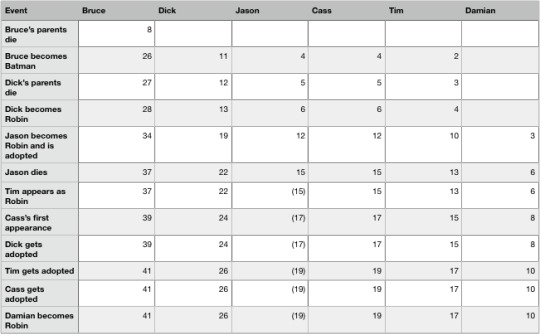
*I’m defining Jason’s age by the time elapsed since his birth, but you could make an argument for using time he has been alive, which is, of course, different. That’s why the parentheses are there.
Age differences

As Robin

----------
Bruce’s parents die
Pretty consistently, Bruce is written as eight years old the night his parents died.
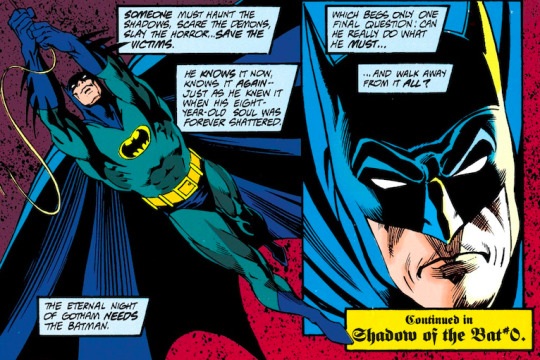
Detective Comics #0 (1994)
This is a zero issue where Bruce thinks back on his origin story. It was written long after Crisis on Infinite Earths (1986), and I tend to give a lot of weight to ages written in summaries of past plot lines, my reasoning being that it’s easier to be consistent in one issue than it is to be consistent through a month to month story.
Bruce first appeared as an adult in Detective Comics #27 (1939), and the Waynes were already dead at that point, so flashbacks are the only available material anyway.
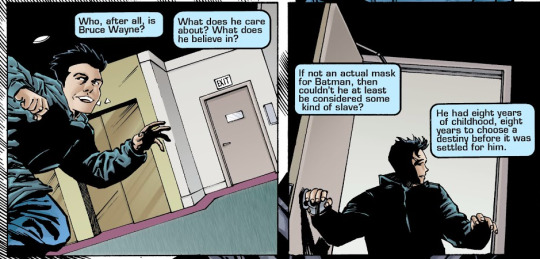
Gotham Knights #6 (2000)
The text is Hugo Strange talking about Bruce, and the image is Tim and Dick playing at Wayne Enterprises.
I’ll take a second here to note that I did find at least one alternate age for Bruce— in Superman/Batman Secret Files & Origins (2003), Bruce was 10 when his parents died. I’m disregarding that in favor of the stronger 8 year old timeline, especially in light of Batman #404 (1987).
Batman #404 is the beginning of Batman: Year One, which was explicitly written to clarify the Batman timeline post-crisis, and it’s the basis of most of my calculations for Bruce and Dick’s ages.
----------
Bruce becomes Batman
According to Year One, Bruce was 26 years old when he became Batman. I’m using his age at his parents’ deaths, his age when he returned to Gotham, and his 18 year timeline.
Batman #404 puts Bruce at age 25 when he returned to Gotham in January.
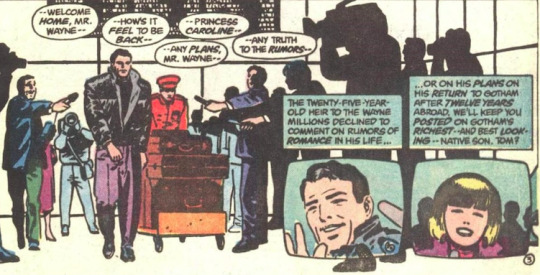
Batman #404 (1987)
Bruce gives his dramatic, “Yes, Father, I will become a bat,” line in March. In the same scene, he says that it has been 18 years since his parents’ deaths. Knowing that they died when Bruce was eight, that puts Bruce at 26 years old the day he became Batman, which makes sense considering Bruce’s birthday is usually set at February 19th.
He was 25 in January, turned 26 in February, and became Batman at 26, 18 years after his parents’ death.
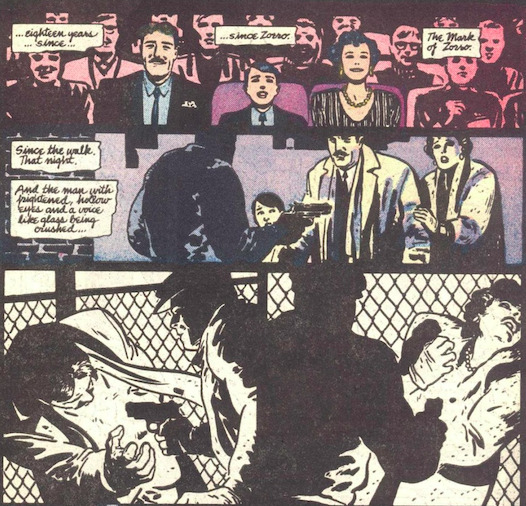
Batman #404 (1987)
Post-crisis, DC built timelines off the “Year” model. Year One is Batman’s beginning, and events after that are measured by how far away they are from the year Bruce became Batman. I’ll be using the Year model for Dick’s life events next.
----------
Dick’s parents die
The Graysons died in Year Two. Using the Year Model, Dick was 12 when his parents died, and Bruce was 37.
Year timelines appear a fair amount, especially in issues titled “Secret Files & Origins.” I pulled this bit from Batman Secret Files & Origins (1997) because it was the easiest to screenshot.

Batman Secret Files & Origins (1997)
Year Two would place Bruce at 27 years old. I’m calculating Dick’s age backwards, based on him being 13 years old during Year Three.
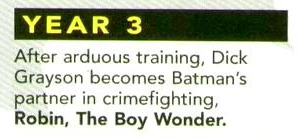
Batman Secret Files & Origins (1997)
----------
Dick becomes Robin
Dick became Robin in Year Three, when he was 13 years old and Bruce was 28. I’m using two different issues to calculate the number.
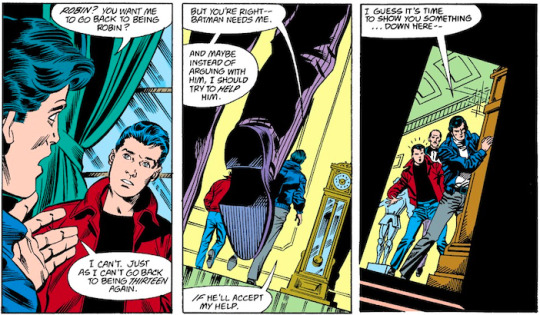
Batman #441 (1989)
Batman #441 is from Tim’s introduction story. It takes place “months” after Jason’s death. We’ll get to that part. In Batman #441, Tim asked Dick to be Robin again in order to help Bruce, who was visibly unstable after Jason’s death. Dick says that he can’t go back to being Robin, just like he can’t go back to being 13 years old. The strong implication there is that Dick became Robin at 13, which corresponds to Dick’s statements in Batman #416 (1988).
In Batman #416, Dick as Nightwing returns to confront Bruce about Jason becoming Robin. He says that he was Robin for six years, and he stopped being Robin at 19.
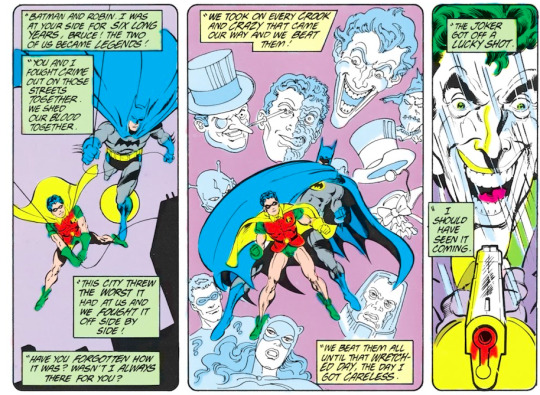
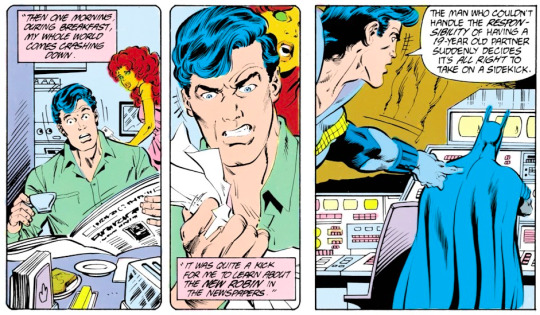
Batman #416 (1988)
If Dick stopped being Robin at 19, after 6 years, that would put him at 13 when he debuted as Robin, the same number from Batman #441 (1989).
Dick was 13 during Year Three, so 12 during Year Two, the year his parents died. Those numbers answer the first bit of my original question. I wanted to know how old Dick and Bruce were when Dick became his child. It’s a bit more of a complicated question for Dick, since he was originally Bruce’s ward, then adopted as an adult.
Based on the timeline so far, Dick became Bruce’s ward at 12 years old, while Bruce was 27.
----------
Jason becomes Robin and is adopted
As previously discussed (see Notes), Jason’s timeline is complicated by Crisis on Infinite Earths (1985-1986). Pre-crisis, Jason first appeared in Batman #336 (1983) as a former circus acrobat very similar to Dick.
Jason’s origin story reboots at Batman #408 (1987), which describes the switch-off between Dick and Jason. I’m building a lot of my timeline off of that issue. At the beginning, Dick gets shot by the Joker, and as Bruce carries him away, the media ask if Robin is dead. Dick isn’t dead, but back at the manor, Bruce decides to retire Robin as a role, based on the idea that crimefighting is too dangerous for a child.
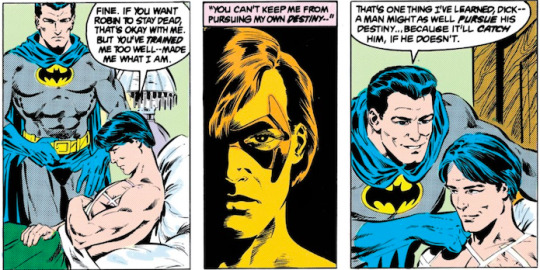
Batman #408 (1987)
This version is more or less from Bruce’s point of view, but there’s a contrasting version from Dick’s point of view later, in Batman #416 (1987). That one has a significantly different tone, and I already cited it once (page 13) because Dick talks about his age and the amount of time he was Robin.

Batman #408 (1987)
The second part of the issue takes place “weeks” later. Bruce goes to Crime Alley to mourn his parents on the anniversary of their death. He comes back to find that somebody stole the wheels off the Batmobile. The somebody was Jason, and by the end of Batman #409 (1987), Bruce is calling Jason “Robin.”
Batman #408 (1987) seems to divide Dick’s departure and Jason’s introduction by only “weeks,” in the post-crisis reboot. Dick’s version of the story in Batman #416 (1987) is much less charitable to Bruce— instead of ending on a panel of Bruce smiling, it shows the aftermath of Dick in tears as Bruce walks away. Dick goes on to describe leaving the house, going to college for a semester, then dropping out. According to Dick, Bruce didn’t even say goodbye.

Batman #416 (1987)
I don’t think the stories are contradictory; they’re just different experiences of the same events, separated by only eight issues. Dick tells us that he was 19 when he left Wayne Manor, and Bruce chooses his new Robin “weeks” later.
As a summary, we know that Bruce’s parents died when he was eight, and that 18 years passed before he became Batman at 26. One year later, Dick’s parents died while Bruce was 27. One year after that, Dick became Robin at the age of 13. From those facts, Bruce is 15 years older than Dick.
All of my calculations of Bruce’s age are based off of the age gap between him and Dick. Dick was 19 when Jason became Robin, so we know that at that time, Bruce was 34. We also know that at that time, Jason was 12.
I can’t show a source for that number because it appears on the letter page of Batman #408 (1987), Jason’s introduction.
Even after a significant amount of investigation, I can’t find a copy of the letter page, but it’s cited by enough secondary sources for me to be comfortable using it. That issue is specifically written to show Jason’s origin, so it makes sense that it would contain Jason’s age at inception, even if the number wasn’t in the actual exposition.
From Jason being 12, we can establish a seven-year age gap between Jason and Dick, who was 19 at the time. Now we know Bruce, Dick, and Jason’s ages, and the age differences between them.

Back to my original question— when did Bruce acquire Jason? We know that Bruce was 34 when Jason became his ward, and Jason was 12. The next question, however, is when did Bruce adopt Jason? On this one, I’m making an educated guess.
Again we have to differentiate between pre-crisis and post-crisis timelines. Pre-crisis, there’s a full storyline about the fact that Bruce did not adopt Jason, although not for lack of trying. In Batman #374 (1984), the Child Welfare Bureau investigates Bruce when it notices that Bruce has not adopted Jason— and is not even, in fact, his legal guardian.
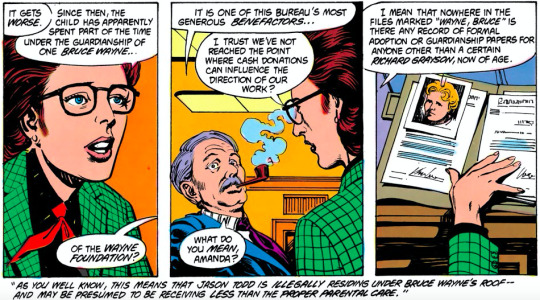
Batman #374 (1984)
The rest of the storyline is about Jason’s custody. A villain named Natalia Knight (Nocturna) adopts Jason in an attempt to get Bruce to marry her in order to become Jason’s father. In the court scene in Batman #377 (1984), Bruce says that he filed to adopt Jason sometime beforehand, although it’s unclear to me whether he means he filed between those issues or the CWB documents were incomplete.
Natalia does adopt Jason in Batman #378 (1984), and he briefly lives with her before returning to Wayne Manor in Batman #381 (1985), directly before the reboot.
I’m including all of that for two reasons: first, I do think it’s important to clarify both this version and the post-crisis version I’m about to address. Second, I spent years under the impression that Bruce adopted Jason pre-crisis because of one, well-known scene.
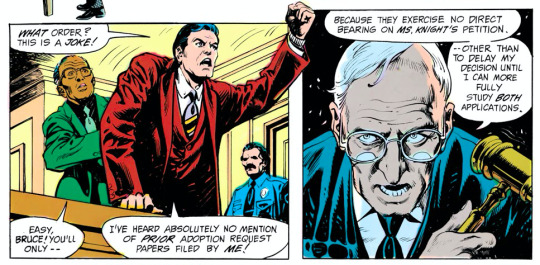
Batman #377 (1984)
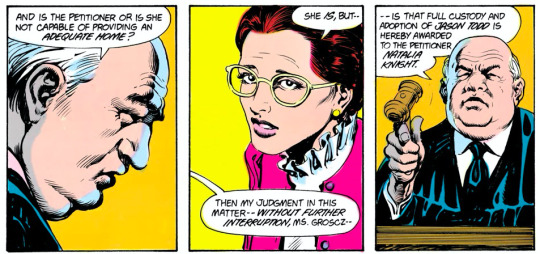
Batman #378 (1984)
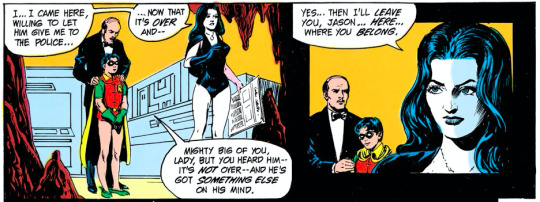
Batman #381 (1985)
Donna Troy gets married in Tales of the Teen Titans #50 (1985). At the wedding, Bruce and Dick have a conversation about Jason and about their own relationship. A few of those panels get spread around because they contain what I would consider a defining moment between Dick and Bruce.
I’m certainly not complaining about the amount of times I’ve seen the wedding conversation, but I think that, in regards to Jason, seeing just those panels has created a misconception.

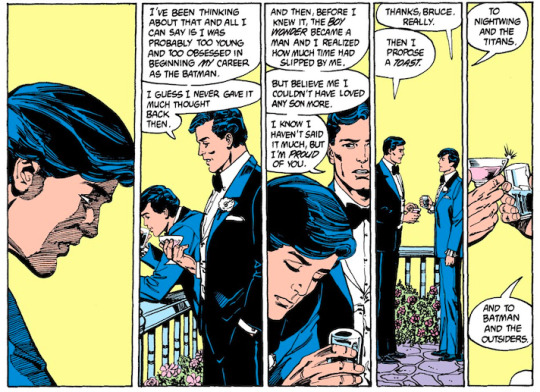
Tales of the Teen Titans #50 (1985)
Without context, it looks, at least to me, like Dick is saying that Bruce has adopted Jason pre-crisis, which isn’t true. This issue takes place between the Natalia adoption in Batman #378 (1984) and Jason’s return to the manor in Batman #381 (1985), and the panels directly before the exchange make that clear. I just didn’t see those panels until I looked through the whole issue for this project.
I’m reasonably certain that in the past, I publicly cited this issue as evidence of Jason’s adoption, and I was wrong about that. [Note: As it turns out, I was only partially wrong. See section Correction.]

Tales of the Teen Titans #50 (1985)
As we see, the wedding conversation is in the context of the Natalia adoption. With that cleared up, and with the pre-crisis timeline filled out, let’s move to post-crisis.
In my brief read-through of Batman #404-427 (1987-1988), I didn’t find any direct references to Jason’s status. Those issues begin at the reboot and end at Jason’s death. However, Dick and Jason’s statements after the fact do tell us that post-crisis, Bruce did adopt Jason.
In Batman #436 (1989), Dick returns to the manor in the direct aftermath of Jason’s death, and while he is there, he sees that Bruce removed any trace of Jason from the house. There aren’t any trophies in the Batcave, and there aren’t any pictures of Jason on the nightstand displaying Bruce’s family photos.
Dick says that Jason was Bruce’s son.

Batman #436 (1989)
I think it’s fair to ask whether Dick is being literal here, because even if Bruce hadn’t legally adopted Jason, it would still be more than appropriate to call them father and son. I’m not going to place my opinion solely on this kind of statement, even if it does appear pretty regularly from 1988 to the end of the timeline.
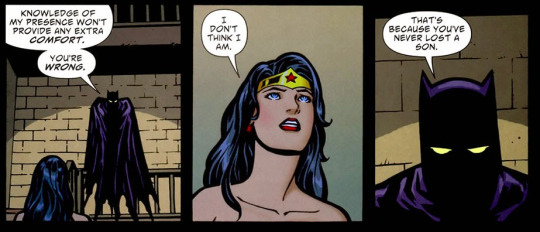
Green Arrow/Black Canary #4 (2007)
We get a more definite answer later, during Tim’s first appearance. In Tim’s origin story, he deduces Batman and Robin’s secret identities after he sees footage of Robin doing a type of flip that only the Flying Graysons could do. Tim was at the circus the night Dick’s parents died, so he saw Dick do the flip there, then saw Dick become an orphan.
Because Tim knew that Dick was the first Robin, he correctly identified Bruce as Batman and Jason as the second Robin. He tells Dick all of this in Batman #441 (1989).
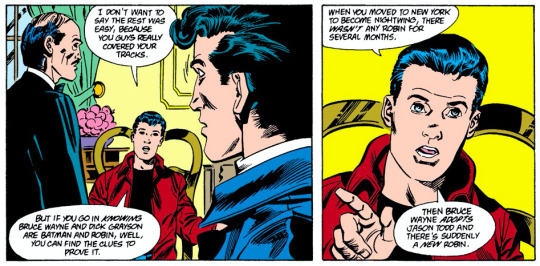
Batman #441 (1989)
Tim does specifically use the word “adopts” here, and that’s good enough for me. The last part is guesswork— I don’t know for certain how old Jason and Bruce were when the adoption took place, but I’m electing to say Jason was 12, the same age as he was when he became Robin.
I picked that number both out of convenience and because Tim seems to be putting Jason’s adoption and the second Robin’s appearance at around the same time. With that in mind, I think that Jason was 12 years old both when he became Robin and when Bruce adopted him. Using the age gap we already established, that would put Bruce at age 34.
Circling back to my original question, Dick became Bruce’s ward when Dick was 12 and Bruce was 27. Jason became Bruce’s ward, then adoptive son when Jason was 12 and Bruce was 34.
At this point in the timeline, Bruce is 34 with one former ward and one adopted son.
----------
Correction
A few days after I wrote my section about Jason’s appearance and adoption, I realized that I was missing a panel citation in my discussion of Jason’s death. The panel is from New Titan #55 (1989), and you’ll see me cite it when I talk about Jason’s death certificate.
New Titans #55 (1989) is the issue where Dick, who is with the Teen Titans, finds out about Jason’s death. While I was combing through the issue for the panels I wanted, I reread a scene I had completely forgotten about. Dick goes back to the manor to speak to Bruce, and it doesn’t go well.
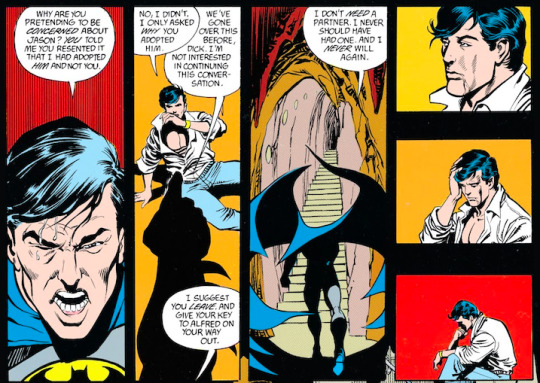
New Titans #55 (1989)
I have three comments here. First, I do think this scene is inconsistent with the simultaneous story in the Batman title. In this version, Dick and Bruce have a very aggressive confrontation, but in Batman #436 (1989), Dick appears to be returning to the manor for the first time since Jason died, and there isn’t any reference to a prior fight.
Putting that aside, Bruce does explicitly say that he adopted Jason, and that’s more, stronger verification of a post-crisis adoption. Lastly, it’s pretty clear that Bruce and Dick are talking about the wedding scene.
I already explained that the wedding scene is pre-crisis, and in the original text, that conversation is about Bruce wanting to, but not being able to, adopt Jason. New Titans #55 (1989) carries the wedding scene into post-crisis canon, changing the language in the process. In this version, Bruce has adopted Jason.
I was still wrong about the wedding scene because in the past, I used it as evidence of a pre-crisis adoption. It isn’t pre-crisis evidence, but it is, in a roundabout way, evidence of the post-crisis adoption. I wanted to clear that up before I move on to Jason’s death.
----------
Jason dies
Jason’s death is by far the shakiest point on my timeline, but I’ve chosen to put him at 15 the day he died in Batman #427 (1988).
I think it’s safe to say that Jason was either 14 or 15 when he died, and my basic conclusion is that running numbers doesn’t give me a definite answer. There’s a cop-out option based on an extraordinarily poor source, and I’m taking the cop-out.
The general consensus seems to be that Jason was 15 at his death, citation to Jason’s death certificate. Jason’s death certificate appears in two different places, and I think most folks conflate the two.
To my knowledge, the only copy of Jason’s death certificate in full appears in The Batman Files (2011), where it does list Jason’s age as 15.
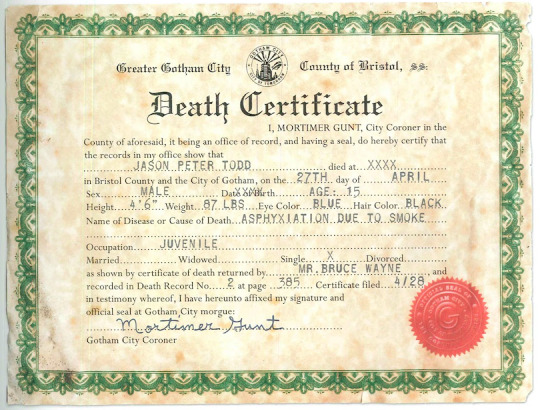
The Batman Files (2011)
Now there is a partial copy in Batman Annual #25 (2006), which I would argue is a very reliable reference when it comes to Jason. That issue is part of the Under the Red Hood story, the one where Jason returns to Gotham for the first time after his resurrection. In fact, the specific annual issue has a timeline for Jason’s events counting forward from his death.
Here’s the problem: the issue doesn’t say his age at death. The partial copy of his death certificate looks like this.

Batman Annual #25 (2006)
I think that when most folks remember a death certificate, they think of this one, the one from a very important issue, instead of The Batman Files (2011) which, as noted, is a very bad source.
I have three issues with The Batman Files (2011): the format, the publishing date, and the other information on the certificate. First, The Batman Files (2011) isn’t a comic book at all. It’s a commemorative book published in collaboration with DC in 2011. Now I don’t think that fact completely removes the book as a source, but it certainly damages its value as one.
My problem with that date, 2011, is that it’s the year the New 52 premiered. I called it a commemorative book because it’s meant to be a look back at a fully complete timeline, a kind of “this is us saying goodbye” product. The date and format alone make me hesitant to cite the certificate, but on top of that, the certificate is inconsistent with prior canon.
I am intimately familiar with retcons and conflicting numbers in the DC timeline. I made a point at the beginning of this paper to tell you that although this is my best attempt to make a cohesive timeline, assuming that I can carve out a cohesive timeline is fundamentally flawed.
I’m not saying that a single contradictory number is enough to make me disregard a source. I am saying that in this particular conversation about an already suspect source, I’m going to take inconsistency into account.
In New Titans #55 (1989), the issue from Corrections, Dick finds out about Jason’s death because a team member notices Jason’s status is set at “unknown.” Dick uses Bruce’s passcode to access restricted information, and he and the Titans see that Jason’s real status is “deceased.”
The death certificate in The Batman Files (2011) marks Jason’s height at 4’6 and his age at 15. In contrast, Dick’s scene puts Jason at 5’4, and its only reference to Jason’s age is a very relatable question from Donna. “How old was he, anyway?”

New Titans #55 (1989)
There’s a substantial difference between the two heights, and I think it’s also worth noting that for a 15 year old American male, 4’6 is in the 0.1 height percentile. In the past, I and many others have tried to justify that height along the lines of Jason being malnourished or similarly afflicted. Personally, I liked the parallel between this height for Jason and Damian’s height at his own death in 2013, and I know I’ve talked about that in the past.
I’m not criticizing anyone for using the 4’6 number, but I do think the unlikelihood of a 15 year old that size is worth bringing up.
In summary, The Batman Files (2011) is so bad of a source that I’m only willing to use it as a last resort. Unfortunately, it’s time for a last resort.
I mentioned a timeline in Batman Annual #25 (2006) that counts forward from Jason’s death. I’m not going to use image cites here because they’re just isolated text boxes labeled either “six months later” or “one year later.”
Using that timeline, we know that Jason’s resurrection took place six months after his death. He spent one year in a coma, then one year on the street, then one year with the League of Assassins. Finally, he spent a nebulous time training before he returned to Gotham.
We know that Jason was gone for a minimum of three and a half years, then whatever time “training” includes. Personally, I’m applying my best attempt at comic logic to say he was missing for somewhere between three and four years.
To understand the next bit, I need to point out that from Jason’s death on, I’m going to be using Tim’s age to track time in the same way I’ve been using Dick’s so far.
As a reminder, I know what age Bruce was when Dick became Robin (28), and I know Dick’s age at the same point (13), so I know there’s a 15 year age difference. As I track Dick’s age through the timeline, I add 15 to get Bruce’s.
In the same way, I know what age Dick was when Jason became Robin (19), and I know Jason’s age at the same point (12), so I know there’s a 7 year age difference. I can use that number ongoing.
I know that Tim was 13 when he made his first appearance as Robin, and I’ll get into that in the next section. After that, I’m placing Dick, Tim, and Cass’s adoptions based on Tim’s age.
To do that, I need to know how much older Dick is than Tim, and I can only get that by knowing Jason’s age at his death, sort of.
How long was Jason Robin? If I had that information, I could establish Jason’s age by counting up from 12, the age when he became Robin, then establish Tim’s age from there.
I can’t really answer that question. There is a panel from Batman #436 where Dick, apparently in his first time at the manor since Jason’s death says the following.
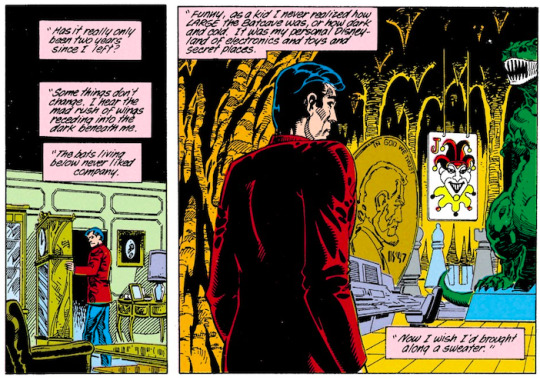
Batman #436 (1989)
My instinctual interpretation is it’s been two years since he stopped being Robin at 19, making Dick 21 and Jason 14. In my opinion, that’s straightforward plain language, but it seems like I’m in the minority on that one, and most folks read it as Dick saying it’s been two years since he was last at the manor. We know from Batman #416 (1988) that Dick’s last visit to the manor was 18 months after Dick left home.
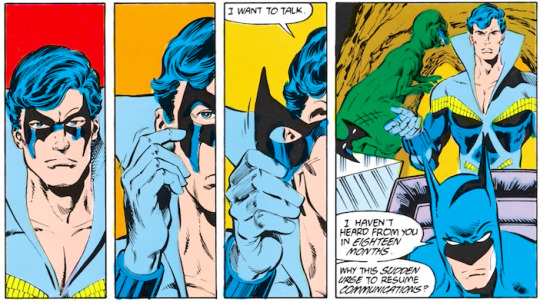
Batman #136 (1988)
I think the most honest thing to say is that Jason was Robin for an indeterminate amount of time that was somewhere between two and three years. I don’t know which number is closer. I also, if you remember, think that Jason was gone from Gotham for somewhere between three and four years, but I don’t know where in that range the real number is.
Here’s why absolutely nothing I’ve said in the past seven pages matters: I need to build my timeline based on the age gap between Jason and Tim.
I don’t know how old Tim was when Jason died.
I know how old Tim was at his first appearance as Robin, and that’s a different number.
We’ll finish this conversation in a moment.
----------
Tim becomes Robin
We begin, thankfully, with a straightforward fact. Tim’s first storyline spans Batman #440-442 (1989). The arc is called A Lonely Place of Dying, and we already talked about it. Tim, having watched Batman and Robin from the shadows for years, comes forwards in the aftermath of Jason’s death in an attempt to convince Dick to become Robin for a second time.
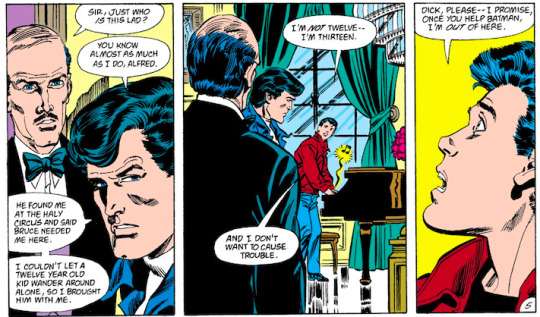
Batman #441 (1989)
We know that Tim was 13 years old at the time, but I do need to clarify exactly what time that was— an indeterminate amount of time after Jason’s death.
The word that pops up a couple of time in Tim’s first arc is “months,” from Tim and Two-Face. How many months? Who’s to say.
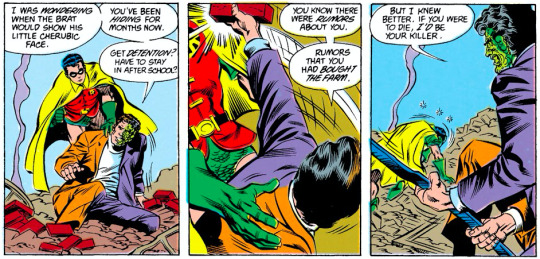

Batman #442 (1989)
So, from the top. We know that Bruce was eight when his parents died, 26 when he became Batman, 27 when he met Dick, 28 when Dick became Robin, and 34 when he met Jason.
Dick was 12 when he met Bruce, 13 when he became Robin, 19 when he left home and Jason became Robin.
Jason was 12 when he became Robin.
Bruce is 15 years older than Dick. Bruce is 22 years older than Jason.
Dick is 7 years older than Jason.
How long was Jason Robin? Unknown, but somewhere between two and three years. At that point, he died. “Months” after that, Tim was 13.
Here, we need to acknowledge that Jason could have been either 14 or 15 at his death, and at the same time, Tim was either 12 or 13. We need to know how far they are apart to calculate Tim’s age in relation to Jason, Dick, and Bruce— ongoing, we will always know exactly how old Tim is, so (if we know how far apart Jason and Tim are) we will always know Bruce, Dick, and Jason’s age from there.
How much older than Tim is Jason? Somewhere between one and three years, I guess, but I can’t really go beyond a well-researched guess. In my opinion, there isn’t a straightforward answer for this one.
Having presented my facts, here is my conclusion. Jason was 15 when he died. At the same time, Tim was 13. They are two years apart.
Why? To begin, I’m more comfortable using the number we already have for Tim, 13, than I am dropping him to 12 on the mere possibility that he could have been 12.
Second, even though The Batman Files (2011) is a terrible source, it does at least sort of indicate that the official DC position is a Jason who was 15 years old at his death.
Third, visually speaking, Jason looks closer to 15 than 14 at his death. Is that good evidence? No, absolutely not. Comic book art is definitionally variable, but I am going to pull a few panels for you to look over.
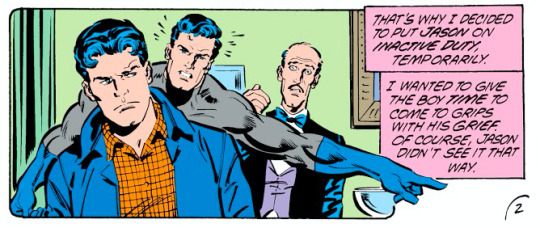

Batman #427 (1988)
Finally, I feel that Jason and Tim are, in later works, treated as if they are different ages. I’m not going to go into much detail on that one because it is purely a personal reaction, but I would refer to Teen Titans #29 (2005) as an example. That issue has Jason and Tim’s first meeting, after Jason comes to the tower specifically to attack Tim.

Teen Titans #27 (2005)
Another well-known issue to check out is Teen Titans #47 (2007).
My basic position is that there are so many ways, all uncertain, to slice Jason and Tim’s ages that I can take my pick. I chose the ones that most closely mirror later canon, fall most squarely into the possible range, and feel the most intuitively right.
They also have the benefit of simplicity, which was very much a factor.
Don’t agree with me? Fair enough. I think I’ve given you enough information to make an educated judgment, and I’ve also gone ahead and made a timeline in the alternative. In this one, Jason was 14 at death, and he and Tim are only one year apart.
----------
In the Alternative
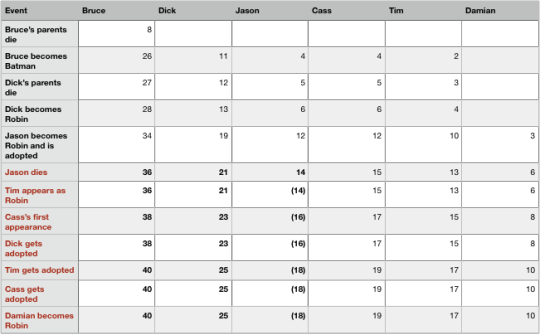
----------
Cass appears
Having progressed beyond Jason and Tim’s age gap, we reenter simple canon. I hope you’re as pleased as I am.
Cass was 17 years old at her first appearance, which we can establish easily based on two different issues. Cass first appears in Batman #567 (1999), during an arc called No Man’s Land. At the time, she is working for Barbara Gordon in the aftermath of an earthquake that destroyed most of Gotham. We learn Cass’s backstory through that issue.
Cass’s biological father is David Cain, a villain, who raised Cass in isolation, never exposing her to a verbal language or allowing any kind of socialization. By comic book logic, her upbringing gave her a near-superhuman ability to understand and anticipate physical actions, as those actions are her only form of communication.
Cain trained her as a child assassin, then took her to her first kill. Cass murdered a man and experienced, through his body language, the pain he felt at his death. Immediately afterward, she ran away from her father.
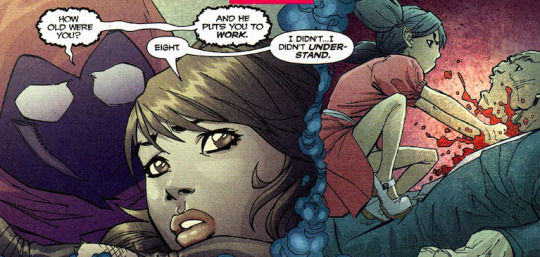
Batgirl #62 (2005)
We know that Cass was eight years old when she killed and ran. We also know that her first appearance in Gotham was nine years after she ran, thanks to Barbara Gordon’s file.
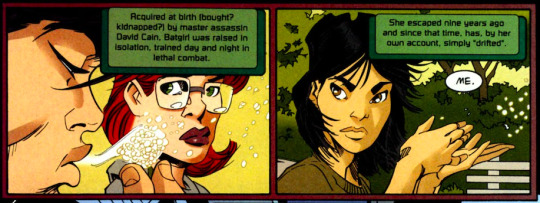
Batgirl #1 (2000)
Simple enough. She was 17. How old was everybody else? We find out from Tim’s timeline.
This next bit will come up a few times. We know that Tim was 15 from at least 1993 to 2003, established by three different issues. We know from Detective Comics #668 (1993) that Tim was 15 during Knightquest, the arc where Jean-Paul Valley was briefly Batman. Barbara tells us in 2002 that Tim is still 15, and Tim turns 16 on-panel in 2003.
In Knightquest, Tim gets his driver’s license early, at age 15, because Jack Drake is in a wheelchair. I suppose the wording here is ambiguous on a technicality, but I don’t think there’s any significant argument against Tim being 15; if he was only 14, the language would be different.

Detective Comics #668 (1993)
Next, in Batgirl #24 (2002), Barbara says she’s “sending a 15 year old” as she reaches for Tim’s com line.
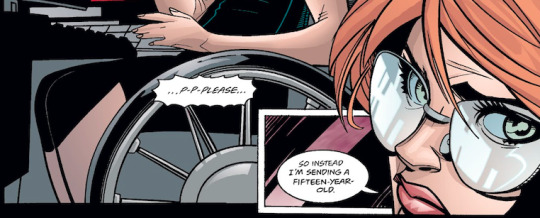

Batgirl #24 (2002)
We could stop here for Cassandra’s appearance, since that happened in 1999, between the 1993 issue and the 2002 reference. For completion’s sake, however, let’s note that Robin #116 (2003) is about Tim’s 16th birthday. He forgets about it, so his step-mother throws a surprise party.
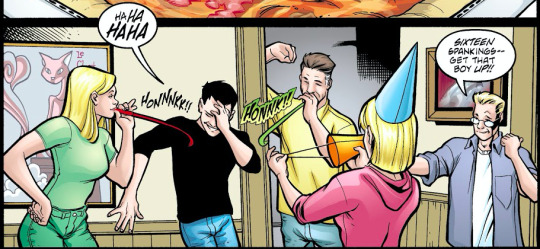

Robin #116 (2003)
Okay, so Tim was 15 when Cass appeared at age 17. That puts Bruce at 39, Dick at 24, and Jason at 17 if you’re counting by years elapsed since his birth.
Bruce met his daughter when he was 39 and she was 17, in reference to my original question. Cass is 22 years younger than Bruce, seven years younger than Dick, the same age as Jason, and two years older than Tim.
----------
Dick is adopted
This one, having already established Tim’s timeline, is very simple. Dick was adopted in Gotham Knights #17 (2001).
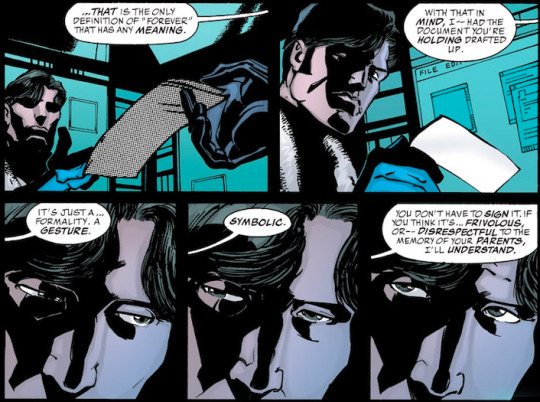

Gotham Knights #17 (2001)
Again, Tim was 15 from 1993 to 2003, and 2001 falls within that range. Tim was 15, which makes Dick 24 and Bruce 39.
At this point in the timeline, Bruce, a 39 year old, has two adopted children, one of whom is deceased as far as Bruce is concerned. His adopted children are (17) and 24. He has already met two of his future children, Cass and Tim.
----------
This is PART ONE. I’ll reblog Part Two onto this post when I wake up, which should be around the same time this posts.
#PART ONE of two#I'm going to reblog the last 10 pages onto this post as soon as it comes off the queue#timeline#mine#really lame that I can fit 50 pages into a post but then the last10 is too much
976 notes
·
View notes
Text
YearnNFT Marketplace Explained! Create Your NFT Portfolio Now.

YearnNFT- the utmost mainstream NFT marketplace developed and deployed on Binance Smart Chain network. Backed by Binance protocols, this project empowers both creators/artists and communities to freely and affordably create, discover, reserve, trade, and leverage NFTs. Assisting all communities interested in NFTs is the core motive of YearnNFT team as they intend to empower the upcoming generation of digital transactions.
This platform serves three groups of users- NFT creators, collectors and traders alike. YearnNFT marketplace allows users to easily create and tokenize the content/asset. Moreover, it is also a spot for every contributor to explore and search for rare and exclusive NFTs from various sources; not only they can trade and distribute NFTs freely but also leverage YearnNFT platform to retrieve financial incentives obtaining from NFT goods.
Why YearnNFT Hits the First Place?
YearnNFT intends to build a trustworthy marketplace where any user can effortlessly trade precious and limited art pieces of digital assets such as collectibles, digital art, gaming assets, etc. The team also ensures the scarcity of every placed digital asset. Moreover, creators can decide on minting digital content in limited phases or access prevailing NFTs from BSC compatible blockchain. The motive of scarcity will guide creators avoid the emergence of secondary markets.
On YFNFT platform, distribution methods are customizable, providing corporate solutions to issue the online content using simple purchase, redemption, auction, etc. The team allows and support various content formats. YearnNFT tries to satisfy various demands of users, thus welcoming wide content from 2D images, 3D models, to music files.
Decentralization is another plus point of this marketplace where trades on YearnNFT happens on Binance Smart Chain and standard smart contracts. Yet community governance is next positive feature in which $YFNFT token holders can freely participate in proposal creating, asset holding and voting.
Not only these mentioned rights but also community members enjoy financial rewards along with additional privileges including exclusive sales and increased limits. The team at YFNFT focuses on cost-efficiency by choosing BSC that provides a fast, cheap, affordable and safe transaction environment for YearnNFT ecosystem. Also, the service fees on this marketplace are quite low.
The $YFNFT Token
$YFNFT token is the utility as well as the governance token of YearnNFT platform. It is basically a BEP20 token developed on BSC. YFNFT holders attain additional benefits if they hold verified amounts of $YFNFT assets.
$YFNFT is designed to be used for transactions and voting protocols. The token holders will have high priority in case of NFT listing. Additionally, the creators who hold $YFNFT can raise their minting and transaction limits.
The token holders at YearnNFT marketplace will also earn a discounted rewards and service fee applicable in specified cases. Not only incredible rewards but also, they will have early access to presales and other events held at the ecosystem. Last but not the least, the token holders can propose and vote to choose the future of YearnNFT.
YFNFT token economy is shown below:
Token Name: YearnNFT
Symbol: YFNFT
Network: Binance Smart Chain
Features: Governance, Fees, Rewards, Payments and Trade
Tokenomics Distribution
Total Supply: 73339 YFNFT
Available Supply: 73332 YFNFT
Presale: 20% (14666.4)
Liquidity: 17.5% (12833.10)
Token Burn: 50% (36666)
a) Registration Bounty 2% (1466.64)
b) Referral Bounty- 2% (1466.64)
c) Influencer reward- 1% (733.32.64)
d) Airdrop reward- 1% (733.32.64)
YFNFT Token Development
a) NFT Publishers Reward- 1.5% (1099.98)
a) Development Team- 1.5% (1099.98)
b) Marketing Team- 1% (733.32.64)
c) Advisers- 0.5% (366.66)
d) Founders- 1% (733.32.64)
e) Investors- 1% (733.32.64)
The highest participating users on the platform will be rewarded through community mining. Interestingly, the platform operates a mechanism to ensure a wider issuance and distribution in the community. There are funding systems and strategies to be used for platform and ecosystem development activities. Lastly, the liquidity funds are reserved to provide liquidity and rational bounties in the future.
For more information about the new announcement and upcoming updates please check out the social media Platforms
website: https://yearnnft.finance/index
Twitter : https://twitter.com/YearnNft
Telegram : https://t.me/YearnNFT
Medium : https://medium.com/@yearnnft
Reddit : https://www.reddit.com/user/YearnNFT/
Facebook : https://www.facebook.com/yearnnft
#YearnNFT#Presale#NFTMarketplace#Minting#Pancakeswap#Binance#BSC#NFTTrending#NFTCollection#Trade#Tokenlisting#YFNFT
8 notes
·
View notes
Text

-Mockups of the two final American SST concepts, the Boeing 2707 and the Lockheed L-2000. | Composite Photo: Justin Gibb
FLIGHTLINE: 136 - AMERICAN SST PROGRAM
Various programs to develop a supersonic transport in the US stretched from the middle 1950s until the early 1970s, but no aircraft ever resulted.
The first recorded supersonic flight (the speed of sound is 767mph at 20°C/68°F at sea level) was on 14 October 1947, when the American X-1, piloted by Chuck Yeager, reached Mach 1.06. By the 1950s, supersonic flight became a more regular occurrence, though it was still almost exclusively restricted to military pilots. Around this time, various projects around the world began to develop airliners that could break the sound barrier too. Designs like the Sud Aviation Super-Caravelle and Bristol Type 223 were sketched, but technical limitations as well as a lack of funding stalled those efforts.
♫NINETY MINUTES FROM NEW YORK TO PARIS♫
Research continued however, and by the early-1960s a new round of programs were started, with BAC (later BAe and BAE Systems) and Sud Aviation (later Aérospatiale and Airbus) joining forces to produce what became Concorde, while the Soviet design bureau Tupolev developed the Tu-144 (NATO reporting name "Charger"). Numerous American carriers placed orders for Concorde aircraft, but spiraling costs and a desire to develop a domestic SST saw those orders canceled in the early 1970s. In the end, only Air France and BOAC/British Airways operated Concorde, while the Tu-144 was exclusively flown by the Soviet state airline Aeroflot.
BUY AMERICAN!
The FAA estimated in the early 1960s that there would be a market for 500+ SSTs by the year 1990. Fearing Anglo-French domination of the airline industry, the US Congress began funding various research programs, and President John F Kennedy announced a National Supersonic Transport program on 5 June 1963. Requests for proposals were sent to Boeing, Lockheed, and North American for the airframes; and Curtiss-Wright, General Electric and Pratt & Whitney for engines. The request stipulated a cruise speed of Mach 3, and a passenger capacity of up to 300. Preliminary designs were submitted on 15 January 1964

-Line drawing of the Boeing 733-790 SST, which initially featured swing wings. | Illustration: Boeing
The Boeing 733 model featured a large blended wing root with variable geometry outer panels, resembling an enlarged Rockwell B-1. The proposal included optional fuselage extensions, potentially increasing capacity to 227 passengers.

-Line drawing of the the CL-823. | Illustration: Lockheed Corp.
Lockheed's CL-823 was functionally an enlarged Concorde, though the wing shape was a cranked arrow rather than Concorde's ogival delta.
The North American NAC-60 was the smallest and slowest of the competitors, potentially transporting 187 passengers at Mach 2.65.
In 1965 the FAA downselected the NAC-60 design, as well as Curtiss-Wright's engine work, freeing up funds for Boeing and Lockheed on the airframe side and P&W and GE for the engine development.
TIME TO SHARPEN YOUR PENCIL.
The FAA scheduled a final selection in 1966, and requested detailed proposals from Boeing and Lockheed. Boeing had gone through several iterations of the Model 733, with the 733-390 being presented in September 1966. The aircraft was one of the first wide-body airliners, with 2-3-2 seating. In the 30-seat first class section, small tv's were to be integrated into a console between the seats, while in the 247-seat tourist class section larger retractable tv's would drop from the overheads every six rows. Externally, the engine pods had been moved back under the tail, and the wings, when swept back, would form a delta with the tail.

-Illustration of the 733-390, with one at maximum sweep and one at minimum. | Illustration: Boeing.
Lockheed's CL-823 had evolved as well, with the L-2000-1 design having changed from a cranked arrow to a delta wing, with the engines separated into individual pods. In order to speed production, the L-2000 was projected to use a derivative of the J58 engine that had powered the A-12 OXCART and SR-71 Blackbird. New requirements from the government saw changes to the wing and fuselage, and the engine pods were redesigned to accommodate either the P&W JTF-17A or GE4 designed as part of the SST program. The final design presented to the FAA was the L-2000-7A/B (the B was 20 feet longer), which had a passenger capacity of 230.

-Advertising image of the L-2000-7A. | Illustration: Monsigneurhulot
THE FINAL SHOWDOWN
The final designs, complete with full-scale mockups, were presented in September 1966.

-The full-scale mockup of the 733-390, in a striking white-over-yellow paint scheme. The size of the plane is evident from the man standing near the third jack. | Photo: Boeing

-Appearing no less impressive, the Lockheed L-2000 mockup. | Photo: Lockheed
FAA review of the competing SSTs took until December, with the Boeing design being announced the winner on 1 January 1967. The L-2000 was judged to easier to produce, but it was also thought to be less risky and advanced than the Boeing entry, and thus the latter was more in the spirit of the design mandate. Also, the Lockheed craft was anticipated to be louder with the JTF-17A engines, as well as being slower.
Boeing anticipated construction of the 733-390 prototypes, now referred to as the 2707-200, would begin in 1967, with first flight in 1970. Construction of the production models was expected to commence 1969, with first flight in 1972 and FAA certification anticipated by 1974.

-The public enthusiasm for the SST program was initially high, with scale models and toys of the design being release by multiple companies. Seattle's NBA team, formed in 1967, was initially named the SuperSonics. | Photo: oldmodelkits.com
NO PLAN SURVIVES FIRST CONTACT WITH THE ENEMY (IN THIS CASE, PHYSICS)
Almost immediately, Boeing began encountering problems with the design. Canards were added to improve flight characteristics, but this added weight. The swing wing mechanism were also much heavier than anticipated, with one pivot section being an eleven feet long, two-and-a-half feet thick piece of titanium weighing 4,600lbs. All of this added weight was eating into the plane's range and lowering the speed, and in October 1968 the company made the decision to delete the variable geometry wings and utilize a fixed delta instead. Fabrication of a mockup of the new design, the 2707-300, as well as two prototypes, commenced in September 1969. Despite these issues and delays, by October 1969 Boeing had orders for 122 2707s from 26 airlines, including Alitalia, Canadian Pacific Airlines, Delta Air Lines, Iberia, KLM, Northwest Airlines, and World Airways.
It was during this period however than organized opposition to SSTs became more pronounced. During the first half of 1964, the FAA conducted Operation Bongo II, under which Oklahoma City, Oklahoma was subjected a total of 1,253 sonic booms. Up to eight booms were scheduled, beginning at 7am and ending in the afternoon. Various aircraft were used, from fighters like the F-104 to bombers like the B-58 and XB-70. The results of the experiment were encouraging, with only 9,594 complaints of damage to buildings, 4,629 formal damage claims, and 229 claims for a total of $12,845.32 ($108.983.34 in 2021). 73% of subjects in the study said that they could live indefinitely with eight sonic booms per day, while 25% said that they couldn't. Approximately 3% of the population filed complaints or lawsuits. The FAA's handling of the program and response to the claims completely undid the public's acceptance of supersonic flight however. The program was undertaken with minimal engagement of the local authorities, and afterwards the FAA dismissed 94% of the claims received, attracting the ire of state and national leaders. Class action lawsuits were filed against the government, and public opinion turned against the SST. This culminated in a national ban on supersonic flight over land. Another source of concerns was the exhaust from the jet engines, specifically nitrogen oxides, which were found to damage stratospheric ozone. A fleet of 500 SSTs was calculated to cause a drop in ozone of 1 to 2%, though changes in fuel and engine technology would help mange this.
THE COLLAPSING STAGE...
The mounting environmental concerns, souring public perception, continuing technical hurdles and competing projects saw the funding for the SST program drying up. Both the House and Senate voted in 1971 to end funding for the program, spelling the end of American SST. Whatever work completed on the prototypes was dismantled, and the one completed 2707-300 mockup was sold to the SST Aviation Exhibit Center in Florida, which displayed it from 1973 until 1981. Hard times saw the closure of the museum, which was then sold to the Faith World Church in 1983. For the next seven years, the Osceola New Life Assembly of God held services beneath the wing of the only remaining example of the US' supersonic airliner program.

-The 2707 mockup some time in the 1980s. Sunday school classes were held under the port wing for nearly a decade. | Photo: Boeing
In 1990 the remnants of the mockup were sold to Stan Hiller, helicopter pioneer and owner of the Hiller Aviation museum. In 2013 the forward 90' section of the fuselage, now all that remained, were shipped to the Museum of Flight was part of a transfer between the two museums. What's left of the 2707-300 is now under restoration; the last remnants of a grand dream to move air travel forward at Mach 3.

-The remaining segment of the 2707, now 50 years after the program's termination. | Photo: Boeing
#aircraft#aviation#avgeek#airplanes#airplane#cold war#cold war history#coldwar#usaf#aviation history#sst#seattle supersonics#supersonic jet#supersonic transport#supersonic airliner#Boeing#Lockheed#the 60s#the 70s#the sixties#the seventies#faa#air travel#Concorde#boac#air france#Tupolev#tu-144#tu 144#concordeski
95 notes
·
View notes
Text
While receiving Rana's full VOCALOID3 voicebank required a ticket from each Vocalo-P Ni Naritai! magazine, every few issues also came with a limited demo copy of Rana. These copies only last a few weeks, and each has different box art matching the magazine issue it came with.
Other boxes that came with each issue include things like tutorials, project files, MikuMikuDance models, and more.

(source (+ image source): @pigeonpigeonn1 on Twitter)
10 notes
·
View notes
Text
Microsoft, Sony bringing Ads to Free-To-Play Games, Nintendo gets hit with Labour Lawsuit, Sega to make Crazy Taxi and Jet Set Radio Live Service Games!
Corporations continue to Corporate, as Nintendo is hit with a Labour Lawsuit that has potentially opened the flood gates for issues within Nintendo. Microsoft and Sony are set to debut live service advertisements directly into video games. Sega confuses fans with the announcement of older IPs returning in the form of Live service games modelled after Fortnite. Several significant games head multiplatform, get more release dates, and Game Boy Emulators for the Switch leaks.
Hey thanks for reading, if there is a game, or just something more in the games space you want me to cover, or report on, please let me know using this Google Form. Thank you.
🕹️ The Console War Rages On
Square Enix to make 'Play-To-Earn' games - Yosuke Matsuda, Square Enix's President, continued to stoke the flames of NFTs, as he has continued to advocate for NFTs in Square Enix's properties openly. A new interview details his desire to make 'Play to earn' blockchain games. He mentions allowing users to create content in the game and then attaining rewards for that effort using technologies like Blockchain. (Source)
Nintendo accused of interfering with workers' rights - A worker has stated that Nintendo of America and the global hiring firm Aston Carter has infringed on their protected legal rights as a worker. The accusations could include surveillance claims, threats, retaliation and layoff or refusal to hire. The current charges on the filing were left intentionally broad. The investigation is ongoing. UPDATE: Nintendo has responded, stating that the disgruntled employee was fired due to leaking confidential information and not for attempting to unionise. @StephenTotilo has said that many have since reached out to him regarding Nintendo of America since the story broke. He continues that there is more to hear about Nintendo of America and possibly Nintendo Japan issues. (Source)
Microsoft to launch advertising network for 'Free-To-Play' games - Microsoft has reportedly been working with and looking to work with advertising technology companies to allow brands and advertisers to buy and place ads in free-to-play game titles. The report noted that the ads could come in the form of Billboards in open-world games. There isn't much other information about how the as could play out. (Source)
Sony also set to debut advertisements in their free-to-play titles - Earlier in the week, Microsoft announced intent for new advertising tech to be integrated into their Xbox free to play properties. Now, Sony is set to do the same. Sony's goal is to give developers a way to monetise their free to play titles. Additional information was revealed, which indicates that Sony will also be considering what much of what Microsoft is for the other parts of the advertisements. (Source)
Sega set to reboot Crazy Taxi and Jet Set Radio into live service games - A new report from Bloomberg states that Sega is planning to reboot Crazy Taxi and Jet Set Radio following the Fornite model as part of their "Super Game" project. Development on the game is still "two to three years" away, although the game has been in development for over a year already. (Source)
No More Heroes III will go multiplatform later this year - After launching on Nintendo Switch last year, No More Heroes III will finally make its way onto PS4, PS5, Xbox, and PC later this year. It seems to be launching with a box set as well. (Twitter)
Shin Megami Tensei V sells one million units. Since launching on Nintendo Switch in November 2021, the game has officially sold one million units making it the best selling game in the franchise. (Twitter)
Teenage Mutant Ninja Turtles gets a collectors edition - TMNT: The Cowabunga Collection LE Collectors set shown off by Konami. It will feature original box art, a cloth poster, an Acrylic diorama, an enamel pin set, 12 tournament fighters cards, and a 180-page art book. (Twitter)
Gameboy and Gameboy Advance emulators for Nintendo Switch have leaked - A thread on 4chan dumped the in-development emulators that are meant to be released for the Nintendo Switch Online service. Users were able to install the emulators on hacked Switches or devkits. The GBA emulator is Sloop, and the GB/C emulator is Hiyoko. It seems that Nintendo Europe R&D. is developing the emulators. Another point brought up was that these leaks have come up from a Switch development kit and not from Nintendo's servers. (Twitter)
Digimon Survive gets a launch date on PS4, Xbox One, Switch, and PC - A Japanese magazine has revealed the launch date and price for Digimon Survive for Japan. The game is set for release in Japan on 28th July 2022 for 6980 yen. A few days after this was released, the game producer announced in a YouTube video the Worldwide release. The game is set for 29th July 2022 across PS4, Xbox One, PC, and Switch. (Source, Update, YouTube Announcement)
Xenoblade Chronicles 3 gets a new release date - Xenoblade Chronicles 3 gets its release date pushed up to 29th July 2022. The game will launch with a special box edition which will include a steel-book case and an art book via the My Nintendo Store. (YouTube Announcement)
Sonic Origins gets a release date - Sonic Origins will be released on 23rd June 2022. The collection will contain Sonic The Hedgehog 1, 2, Sonic 3 & Knuckles, and Sonic CD. The games have been digitally remastered. However, the game is marred by the seemingly complex Pre-order bonus chart. Sega has decided to place things as simple as Character Animations in the main menu behind an additional "Premium Fun Pack". Hard missions as well are only part of this pack. This led to Devolver Digital making fun of the chart on Twitter. (Homepage, Devolver Digital Twitter)


✨ Going to Events Spiritually
Xbox Game Pass announces new games for the second half of April. More games from Ubisoft are also set to arrive on the service. (Source)
Gamefly has a pretty big sale on pre-played games called the Pre-Play Sale. (Source)
🎮 Where's My Controller?
Xenoblade Chronicles 3 is getting a new release date, so I've decided to play the original two games. So there is that.
I've put down Ghostwire: Tokyo, but I want to complete it. My job search continues to take up a lot of my free time.
🎵 Turn it up to 11!
Nothing is more legendary than the impossible to play "U.N Owen was her". The original piece from the Touhou game franchise continues to be an absolute trip across its run time. I implore you to look into the other songs from the Touhou franchise. (YouTube)
📝I don't know what a pen looks like.
Nothing in the writing department. You may have noticed I've changed how I report the news headlines. I'll be trying a few new things over the next month as I prepare more things for Void0 as a whole.
💖 Enjoy this newsletter?
Forward to a friend and let them know where they can subscribe (hint: it's here).
The Void Calls, Will You Answer?
#video games#news#industry#xenoblade#nintendo#sega#microsoft#sony#newsletter#touhou#no more heroes#tnmt#teenage mutant ninja turtles#fornite#square enix#jet set radio#crazy taxi
2 notes
·
View notes
Text
Random Pokemon Generator v2
Anyone remember when I made a Random Pokemon Generator 3+ years ago? No? Well shoutout to those of you who do and Noel (who’s politeness prompted this), because I finally updated it! But first, for those who have no idea or don’t remember what I’m talking about…what am I talking about?
Random Pokemon Generator
Push button > get a randomly generated Pokemon or 6. Many of these exist on the internet so why’s mine different? Well there’s a lot of filters and you can generate as many Pokemon as you want!
What’s been updated?
I overhauled it. It’s better optimized and should be easier for me to update going forward. It also has its own unique look now instead of looking like just another page on my main site. This isn’t just for the aesthetics (as much as I like the different aesthetics), but it helps with optimization and some future ideas. I also changed the file path, so make sure to update your bookmarks.
Galar Pokemon! Finally added them!
Icons instead of animated 3D models. The animated 3D models are harder to source and prevented me from including certain Pokemon that didn’t have them. The icons are easier to source and edit if needed. As well, those with weaker internet connections should find they load faster.
Basic Filters/All Filters tabs. Instead of an all or nothing approach to the filters, I’ve made two tabs. Basic Filters has filters commonly found in Random Pokemon Generators for quick and easy randomizations, while All Filters contains all the filters (more are planned and in development!).
Forms to Include filter has been split. Forms to Include was previously a flat structure, each Pokemon could only be marked as one form type. That’s now been split between “Forms” and “Tags”.
The Tag Filter is like Forms to Include, but Pokemon can now be marked with multiple tags. They’re split between Species and Form Tags for clarity. I’ve added some new ones as well (like Legendary, Sexually Dimorphic, etc).
The Form Filter (new one) has two toggles: one for whether to include all forms or just the species and another to remove cosmetic forms, aka forms that just look different. If you run the randomizer without the cosmetic ban, you have a ~5% chance of getting Alcremie. Because it has 64 forms. It’s a lot.
Better Management. So I learned a thing or two about project management since becoming a tech lead somehow (go imposter syndrome!). In the footer of the new randomizer you’ll find an updates log (About > Change Log), future ideas and in-progress features (About > Project Tracker), as well as a contact links if you find any bugs or have suggestions (Contact or About > Bugs/Suggestions).
Now the big statement: I will update this again and it won’t take 3 years. “When will the next update be?” Honestly? IDK. My day job involves me programming 8 hours a day, so over the past few years I generally avoid programming in my spare time because of burn out. Art and video games are nice breaks from that. That said, with the improvements made in the overhaul and a better understanding of project management (go pseudo-agile practices!) I should be better at targeting smaller but more frequent updates.
Next update is already underway and will be adding even more filters~
You can check it out here if you’d like! (saving you from having to scroll back up to get the link ;D)
#alcremie#galar#galar pokemon#pokemon#pokemon randomizer#randomizer#update#Apps#Random Pokemon Generator
26 notes
·
View notes
Photo


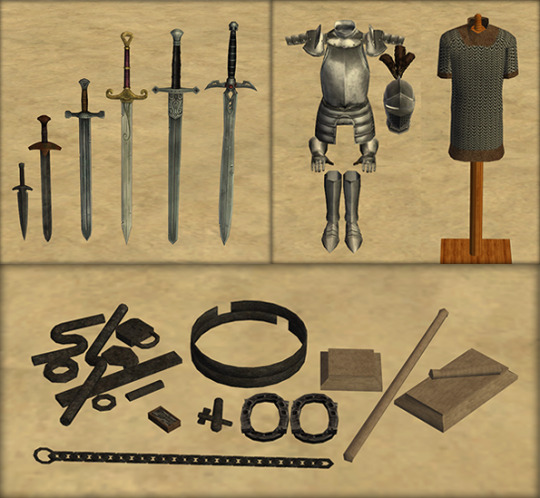




Forging On - Metalsmithing Station
Steel yourself and strike while the iron is hot! With an anvil and the proper body skill, a sim may forge various components, wares, tools, and even weapons and armor.
Download Metalsmithing - SFS
Download Auto Tool Update - SFS
Download/View - The Keep
See under the cut for details and instructions, or visit the Keep link for the same and more images.
REQUIRED OTHER SUN&MOON SETS:
● Refine And Shine – Metal Ingots, Shovel Tool
● All Fired Up – Fire Grates
● Great Grains – Field Sickle Tool
● Cheese Please – Cheese Knife
● Gone Fishin’ – Fillet Knife
● Mining 3.0 – Pickaxe
● Rainy Day Savings – Metal Safes/Strongboxes
● It’s A Trap! – Animal Traps
THE ANVIL:
This is the station used for metal smithing. It comes in two versions, one that is a whole set up of anvil on stump with quenching barrel, and the other that is just an anvil to be placed anywhere. Of course if you choose just the anvil, be aware that the animation may be off depending on the height of the surface it is placed.
Skill Level 0-2: Perfect starting projects for an apprentice or someone just getting into the craft. Learn the basics first!
● Wooden Components ● Chains ● Nails ● Findings ● Hoops
Skill Level 3-4: Now that the basics are there, time to learn to make more complex or delicate shapes and bends.
● Previous Tier Items ● Horse Shoe Set ● Spigots ● Sink and Washtub ● Tools
● Kitchen Utensil Set ● Lanterns ● Alarm Bells ● Tableware Sets ● Animal Traps
● Candlesticks/Holders
Skill Level 5-6: Those shapes are muscle memory now, time to get to confidently producing more sturdy goods prone to wear and tear.
● Previous Tier Items ● Cookware Set ● Security Keys ● Stoves ● Fire Grates
● Buffet Platter ● Safes
Skill Level 7+: Items that require more fine detail or precision are now the goal.
● Previous Tier Items ● Idols ● Iron Sword ● Mail Armor
Writ Of Mastery:
● Previous Tier Items ● Plate Armors ● Steel Weapons
FUNCTIONAL ITEMS
ANIMAL TRAPS:
While the files for the traps themselves are not included in the download, the metalsmith station is capable of making three fully functioning animal traps. *Note: Traps are not restockable from inventory in a business setting. Future update to Animal Hunting will cover that.
● Fox Trap ● Wolf Trap ● Bear Trap
PORTION KNIVES:
● Cheese Knife ● Fish Fillet Knife
LANTERNS:
Place Anywhere/Holdable Lanterns: Copied files of existing creations from Ocelotekatl who allowed me to incorporate the files into the station. Retains old GUIDs, but have been renamed and given Restocking From Inventory Code. Accessory packages are included.
● Box ● Cylindrical ● Oblong
STOVES:
● Skyrim Cauldrons/Pots/Spit: Copied files of existing creations from Sunni. Retains old GUIDs, but have been renamed and given Restocking From Inventory Code.
● Muffin Maker: Copied files of existing creations from Motherof70. Retains old GUIDs, but have been renamed and given Restocking From Inventory Code.
● Cooktop Ring: A stove that can be placed on countertops or anywhere really.
● Pot Belly Stove: Copied files of existing creations from Numenor. Retains old GUIDs, but have been renamed and given Restocking From Inventory Code.
● Eva's Hanging Cauldron:Copied files of existing creations from Eva/Sunni. Retains old GUIDs, but have been renamed and given Restocking From Inventory Code.
● Auld Crow Stove: TS2 stove with some bits and bobs removed.
BELLS & KEYS:
● Fire Alarm Bell: Copied files of existing creation by Kate. Retains old GUID, but has been remapped, renamed and given Restocking From Inventory Code
● Alarm Clock Hand Bell. Based on Inge's Alarm Clock for more customization and setting.
● Security Keys - Custom Burglar Alarm. Make sure to download Midge's Mod for Custom Burglar alarms to make it work.
BANKS
While the files for the banks themselves are not included in the download, the metalsmith station is capable of making three fully functioning metal banks.
● Skyrim Metal Safe ● Skyrim Strongbox Safe ● Witcher Metal Safe
SWORDS/DAGGER:
Based off of Paladin's Dueling Swords, but heavily modified, new weapons are available for use by sims teen and older.
All swords and the dagger may perform the following actions:
● Challenge: This action allows two sims to spar with swords. They will continue to do so until they reach motive failure, but the action can be interrupted at any time.
● Practice: This action allows a sim to practice their sword work and footing and thus gain mechanical (dexterity) skill. Note that the sword will “disappear” from where it has been placed with this action, representing a sim has it in use.
● Kill: This action allows the current selected sim to have a brief fight with another sim and the target sim will die at the end of the fight. Use with caution, death is always the outcome for the target sim.
● Grab: Standard Grab function that adds a sword into a sim’s inventory. It is enabled for visitors, as well as children. So deliveries can be made, or thievery can happen. The grab in non-autonomous however.
All Swords use NixedSims Accessory Swords from her Training Dummies V3 set, and retain their original GUIDs. If you have these already in your game you can delete them from this set.
Each Sword utilizes 5 packages. All swords share the FIGHT AREA package but must have their own Object, Accessory, and Actions Packages. Different swords cannot share the latter 3.
IDOLS:
Models picked based on aspects they can represent rather than any real world religion. These objects are a combination of the available actions found on KevinHope's Cross and Rebecah's Bible. Each comes in gold/silver/bronze recolors.
● Azura ● Dibella ● Mara ● Meridia ● Mermaid ● Watcher
WASH BASINS:
Two items for hygiene and cleanliness. The tub is enabled for pets, and the sink is a place anywhere style.
● Metal Washtub - Bathtub ● Basin Sink
ARMOR:
These smithed items can be sold to a sim who can then use it for an actual clothing grant to their wardrobe. It is one time use, thus incentivising a smith to continue to make more. There are five levels of armor that require different base metals: Iron, Steel, Gold, Mithril, and Chain. Armors DO NOT come on prebuilt display racks. They float in the air and are meant to be slotted into a display.
STATIC/SLOTTED ITEMS
COMPONENTS:
Components are to be used as parts in the making of other items. They are purely deco and intended for sale or further refinement.
● Chain ● Nail Box ● Spigot ● Hoops ● Findings ● Horse Shoe Set ● Wooden Bits and Bobs
INVENTORY TOOLS:
The metalsmith may craft any autonomous inventory tool from Sun&Moon sets. The versions of the auto tools included in this download are updated with restocking code ans should replace any previous versions in any set released thus far. *Not pictured: Shears
COOKWARE/KITCHEN UTENSIL SETS:
A set of items that when opened places single items into a sim's inventory. These items are considered inventory tools for future stations, as well as decorative slotted items.
● Cookware Set Contains: Stock Pot, Gratin Pan, Pancake Frying Pan, Roasting Pan, Sauce Pan, Saute Pan, and Wok.
● Kitchen Utensil Set Contains: Spatula, Dipper, Slotted Dipper, Ladle, Large Fork, and Whisk.
TABLEWARE SET/PLACE SETTINGS:
A set of flatware, charger, and drinking vessel to set upon your sims tables. Sims will place their bowl/plate on the charger and eat. Each set has an invisible recolor of the drinking vessel/flatware so that they can be hidden. With everything but the charger plate hidden, players can decorate around the plate using five different slots with tableware or items of their choosing. Comes in three styles; Lower Class, Middle Class, and Upper Class. Each set has a different drinking vessel and is made of a different metal.
CANDLE HOLDERS:
A set of various candle holders with functional slots.
● Fancy Candlestick - Tall and Short ● Fancy Candelabrum
● Simple Candlestick ● Simple Candle Dish
BONUS ROUND
ARMOR STANDS:
You can’t have your armor just floating there in the air (unless it’s an enchanted shop of course) so you have to have something to put it on. Some basic wooden armor stands that are found in the catalog under Surfaces > Shelves. The Armor stand has two slots to pop in Armor of your choice and a sword of your choice. The Chainmail Shirt stand had one slot.
CHAIN DISPLAY STAND:
Can't have floating chains either, so store them here. Five slots for five lengths of chain. Can be found in the catalog under Surfaces > Shelves.
REFERENCE TOME:
A handy dandy knowledge source to know how to craft various items. This will tell you what metals and how many of that metal you will need for each item. Can be found in Hobbies > Knowledge.
REPO FILES:
This set is HEAVILY respositoried. A list of all main files follows:
● Sun&Moon-Smithing_Product_TablewareSet_LowerClass
● Sun&Moon-Smithing_Product_TablewareSet_MiddleClass
● Sun&Moon-Smithing_Product_TablewareSet_UpperClass
● Sun&Moon-Smithing_Product_Cookware_StockPot
● Sun&Moon-Smithing_Product_KitchenUtensil_Spatula
● Sun&Moon-Smithing_Product_Findings
● Sun&Moon-Smithing_Product_Candlestick_Fancy_Tall
DUPLICATE FILES:
All items from other creator’s sets have been renamed to match the file structure, and have been given additional restocking code or other minor updates. They retain their original GUIDs and should be removed in favor of these versions of files.
EXTRA CREDITS & THANKS:
Nixedsims, Davina, Fire_flower, CelestialSpider, crowderhead (sims-historicalish), Gayars, Ocelotekatl , mustluzcats, solfal, Paladin, Sunni, Mo70, Liz, Sherahbim, Inge, Cynnix, Maxis, Cassandre, Numenor, S99, Kate, TSM, TS3, Skyrim, The Nexus, DAZ3D, Unity.
#ts2#ts2cc#s2cc#the sims 2#sims 2#sims2#download#custom content#cc#mod#crafting station#star factory#sun&moon
267 notes
·
View notes
Text
How Is Customer Sentiment Analysis Done?
There are four main stages in customer sentiment analysis. They entail gathering, processing, and analyzing the data for sentiment. And finally, visualizing it on a sentiment analysis dashboard. Let’s look at these stages in detail.
Stage 1: Gathering the data
The most important thing to remember at this stage is that we have to choose the best set of data we can. The larger the data, the more granular and accurate the insights will be. For example, if you want to analyze video comments for sentiment, a video with 500 comments will give you better insights than one with just 30 or 40 comments. We can gather this data either through live APIs for social media such as those allowed by Instagram or Facebook, or we can scrape them manually and upload them onto a sentiment analysis platform as a .csv file.
Stage 2: Processing the data
Now that we have collected the data and ensured that it is relevant to our project, we will upload it to the emotion mining platform, which will now process it using different tasks such as the following -
Audio transcription - Turning podcasts and audio from a source video into text through speech-to-text software.
Collecting caption overlay - Read and extract captions if present in videos.
Capturing Images- Use optical character recognition to capture and extract images if any in the video or text data.
Logo recognition - Identify, capture, and extract logos in the video background like a poster on the wall or a logo on a mug. (This stage is vital for competitor brand analysis, especially in user-generated videos.)
Text analysis - All the text is extracted including emojis, hashtags, industry jargon, acronyms, social media code switches, etc. (This part is essential to parse false positives from sarcastic comments, for example.)
Stage 3: Analyzing the data
Customer sentiment analysis can involve multiple languages that the machine learning model might have to analyze. This means that the model needs to have speech taggers for each language it is analyzing or else the results could be quite inaccurate due to translations.
Apart from this, there need to be custom tags created for different aspects and themes in the data. In this way, the model will be able to extract and segregate the data. Sentiment scores will also be assigned to emotions with polarity. It is this polarity that will be calculated overall in a text and a sentiment score assigned to the comment. When combined, the aggregate score of the brand will be from a range of 0 to 100, with 100 being the highest positive score.
All these processes will be used to train the model. Finally, it will be tested against a validation dataset to check the accuracy of the insights. A good model will give the optimal accuracy within three interactions of training.
Stage 4: Visualizing the insights
Now that our machine learning model gives the most accurate results, we can analyze any customer sentiment analysis dataset and see the results on a visualization dashboard. You can see the sentiment analysis in a chart, as well as finer details like emotion-aspect co-occurrence that will tell you which emotions are the highest in relation to which aspects, and many findings like this.
2 notes
·
View notes
Text
121 Cloud Transformation benefits you'll get which show you do it well:
121 Cloud Transformation benefits you'll get which show you do it well:
1. Economically transform your data management systems to solve your most pressing issues while preparing for future growth.
2. Keep a handle on costs if you have a hybrid infrastructure that includes public and private clouds, as well as on premise resources spread across multiple data centers.
3. Transform raw data into meaningful information that you can use for decisions.
4. Begin a cloud journey that will drive successful workplace transformation, keep your business safe, and align with your business objectives.
5. Transform your IT organization to effectively support Cloud enabled business models.
6. Take full control of your hybrid, multi cloud environment to meet the ever changing demands of data driven transformation.
7. Take full control of your cloud and on premises environment to meet the everchanging demands of data driven transformation.
8. Transform your business using public cloud the smart way.
9. Make sure that you gain everything that has been promised to you.
10. Transform for success in the future while running your business today.
11. Make your applications and data 7x24x365 available in a secure manner.
12. Use technology to transform what happens in your business and the industry.
13. Monitor what happens to your data over a diverse cloud based supply chain.
14. Transform IT when you barely have the resources to keep your current environment up and running.
15. Design an optimal cloud solution and integrate it with your existing business applications.
16. Transform your business model for hybrid cloud.
17. Transform your business by allowing it to take full advantage of the Public Cloud.
18. Integrate the delivery strategy with your current business applications.
19. Build your data center to accelerate your digital transformation.
20. Enable innovation while protecting your data and ensuring compliance.
21. Transform your IT shop to allow your customers to consume cloud services from a centralized service catalog .
22. Make sure you realize the business benefits of your transformation program.
23. Transform your data to the new format and structure.
24. Transform your business without disrupting operations or alienating your customers.
25. Expect the number of cloud based applications used in your organization to change in the coming year.
26. Know your data is secure.
27. Engage your business stakeholders in this transformation.
28. Build this into your business plan.
29. Prepare your business for transformation.
30. Know when you have arrived.
31. Adapt your sourcing model to new development models and cloud.
32. Make sure your information is appropriately managed and in compliance.
33. Know if you need to transform your help desk.
34. Track and maximize the value produced by your major technology investments.
35. Determine the best way to consume cloud services for your organization.
36. Make sure you get the best value out of Cloud.
37. And your organization understand and implement a digital procurement transformation.
38. Expect the number of clouds your organization runs to change in the coming year.
39. Build your organization case to shift to hyper converged infrastructure.
40. Start transforming your organization with SAP S/4HANA and cloud to meet todays needs as well as tomorrows challenges.
41. Programmatically go to market and capitalize on the opportunity to both upgrade your customers and convert them to your new cloud offering.
42. Use a cloud deployment to shift towards your organization of the future.
43. Expect the role of your risk function to evolve in the next three years.
44. Want your users to access the technology.
45. Keep your adoption plan moving forward and see greater benefits from your cloud transformation.
46. Adapt your organization to increase your benefits from Cloud.
47. Know which services your employees are using.
48. Realize the cost benefits envisioned from your cloud transformation journey.
49. Identify and evaluate the right partners to help you.
50. Transform your WAN to support your physical locations, cloud resources, and mobile users.
51. Make an accurate assessment of your organizations degree of maturity and capabilities for a successful cloud implementation.
52. Change your ETL process to carry out sensor calibration systematically in the future.
53. Communicate the vision and engage your organization on a large scale.
54. Integrate applications in the cloud with your other apps.
55. Integrate the Public Cloud while still retaining control of your data.
56. Optimize your operating model to perform and transform more efficiently.
57. Drive bold transformation in your organization over the next 10 years.
58. Better understand your cost of consuming IT from anywhere.
59. Transform to digital without breaking your organization or ignoring the corporate DNA.
60. Want to visualize your organization of your devices.
61. Transform your team from order takers to innovators.
62. Integrate the cloud environment into your current operational platform.
63. Improve your citizens quality of life.
64. Help change your organization.
65. Want to restrict access to your cloud.
66. Know if you are achieving the ROI you want out of your transformation efforts.
67. Accelerate your own workforce transformation.
68. Get your cloud compliance under control.
69. Best be supported in your journey to the cloud and digital transformation.
70. Keep your organizations files, applications, and accounts safe on the cloud.
71. Get buy-in from your team for DevOps.
72. Support your customers during the digital transformation process.
73. See your role in the transformation and in the future.
74. Monitor your cloud apps performance.
75. Use the cloud to completely transform your business.
76. Fill the skills gap in your workforce.
77. Determine the right cloud vendor for your business.
78. Easily and quickly execute on your cloud strategy.
79. Ensure that the cloud setup is right for you.
80. Keep your customers with you.
81. Make sure you migrate to the cloud smoothly and quickly.
82. Begin the journey to transform your digital core with SAP S/4HANA Cloud.
83. Set yourself up to transform your environment and modernize applications.
84. Model leadership in your home schooling environment.
85. Expect this to influence your operating model.
86. Better control, manage, and secure such environments and your workloads.
87. Know if you are getting it right.
88. Know when you are leveraging DevOps effectively for driving digital transformation.
89. Ensure your IT is secure from anywhere.
90. Structure your teams for success.
91. Access your files offline.
92. Know if you are on the right track to success.
93. Build or encourage a diverse workforce within your business.
94. Accurately assess your environment.
95. Protect your trees and minimize stress during the landscape transformation.
96. Consider digital transformation with your customers.
97. Transform your workforce so that it embodies characteristics.
98. Digitally transform your enterprise.
99. Typically route invoices for approval in your organization.
100. Handle your legacy applications.
101. Transform ourselves, your jobs and the places you work.
102. Build your Foundations in Google Cloud.
103. Help you realize your goals.
104. Increase womens participation in your project/program.
105. Assess your readiness for an IIoT transformation.
106. Reduce your sourcing costs.
107. Package and sell your support.
108. Transform your relational data.
109. Backup your applications.
110. Manage your Transformation.
111. Transform your organization.
112. Be transformational if you ain fit got no cash.
113. Manage your cloud.
114. Transform your schools.
115. Organize your people into teams.
116. Transform your people and processes.
117. Backup your documents.
118. Be sure you are compliant in the cloud, at the source, and in between.
119. Transform your daily business.
120. Improve the health of your people.
121. Lower your environmental footprint.
To visualize the Cloud Transformation work and manage it, I have built a Cloud Transformation Kanban board that is broken down into hundreds of Work Items that are prioritized into their Workflows. It's for where to get started on your current or impending Cloud Transformation journey.
How many tasks can you move to Done?
Check it out here: https://theartofservice.com/Cloud-Transformation-Kanban
4 notes
·
View notes
Text
PeckShield says $15M lost on Crypto.com, Tesla accepts doge
After a rough start to the year, the price of bitcoin is about flat in the last seven days. The largest cryptocurrency by market value is currently trading at $41,671, according to Coin Metrics.
Ether, the second-largest, is up about 2% in the same time frame. It’s now priced at $3,113.
Other top coins had a better week. Cardano, Terra and Dogecoin, for example, jumped over the last seven days, Coin Gecko data shows.
Along with price movement, here are six important things that happened in the crypto space last week.
1. Kim Kardashian and Floyd Mayweather sued by investors over alleged crypto scam
In June, Kim Kardashian posted an Instagram Story promoting a cryptocurrency called EthereumMax.
“Are you guys into crypto???” she wrote. “This is not financial advice but sharing what my friends told me about the Ethereum Max token!” Kardashian included the hashtag “#ad,” which indicates that the post was paid for as promotional content.
A class action lawsuit in the U.S. District Court for the Central District of California was then filed on January 7, accusing Kardashian and other celebrities, like Floyd Mayweather, of “making false or misleading statements” about EthereumMax to allegedly increase its price.
Ryan Huegerich, a New York resident, filed on behalf of himself and other investors who bought EthereumMax between May 14, 2021 and June 17, 2021. The lawsuit claims Huegerich and others lost money on their investments.
Representatives for Kardashian and Mayweather were not immediately available for comment when contacted by CNBC. A spokesperson for EthereumMax told CNBC that the lawsuit was “riddled with misinformation” and disputed accusations that it was a scam.
2. Jack Dorsey creates a legal defense fund for bitcoin developers
On Wednesday, Twitter and Block founder Jack Dorsey announced plans to create a “Bitcoin Legal Defense Fund.”
“The Bitcoin Legal Defense Fund is a non-profit entity that aims to minimize legal headaches that discourage software developers from actively developing Bitcoin and related projects,” Dorsey wrote in an email.
The fund will defend bitcoin developers from lawsuits, “including finding and retaining defense counsel, developing litigation strategy and paying legal bills,” with volunteer and part-time lawyers, he wrote.
3. Block will build a bitcoin mining system
On Thursday, Dorsey confirmed that Block, formerly known as Square, will be “officially building an open bitcoin mining system,” he tweeted on Thursday. The company first announced that it was considering the project in October.
Bitcoin operates on a proof of work (PoW) model, where miners must compete to solve complex puzzles in order to validate transactions. The process isn’t easy: It requires a lot of energy and computer power, which isn’t cheap. The computers themselves, along with other equipment, can also be very expensive.
With these types of difficulties in mind, the project’s goal is to make mining bitcoin, the largest cryptocurrency by market value, “more distributed and efficient,” tweeted Thomas Templeton, the company’s general manager for hardware.
Templeton mentioned that there are a number of “customer pain points” and “technical challenges” in the mining community that Block hopes to address, including mining rig availability, high price, reliability and power consumption.
4. Cash App integrates with the Lightning Network
Dorsey has continued to focus more on bitcoin since his departure from Twitter in November.
On Monday, he announced that Block’s Cash App integrated with the Lightning Network, which enables faster, cheaper bitcoin transactions. This now allows Cash App users in the U.S., except those in New York, to send bitcoin for free to anyone globally.
5. Tesla accepts dogecoin for merch payments
6. Crypto.com users report ‘suspicious activity’
//platform.twitter.com/widgets.js
source https://usapangbitcoin.org/peckshield-says-15m-lost-on-crypto-com-tesla-accepts-doge/
source https://usapangbitcoin.wordpress.com/2022/01/19/peckshield-says-15m-lost-on-crypto-com-tesla-accepts-doge/
1 note
·
View note
Note
the
Sims is a series of life simulation video games developed by Maxis and published by Electronic Arts. The franchise has sold nearly 200 million copies worldwide, and it is one of the best-selling video game series of all time.[1]The games in the Sims series are largely sandbox games, in that they lack any defined goals (except for some later expansion packs and console versions which introduced this gameplay style). The player creates virtual people called "Sims," places them in houses, and helps direct their moods and satisfy their desires. Players can either place their Sims in pre-constructed homes or build them themselves. Each successive expansion pack and game in the series augmented what the player could do with their Sims.The Sims series is part of the larger Sim series, started by SimCity in 1989. Game designer Will Wright was inspired to create a "virtual doll house" after losing his home during the Oakland firestorm of 1991 and subsequently rebuilding his life.[2][3] Replacing his home and his other possessions made him think about adapting that life experience into a game. When Wright initially took his ideas to the Maxis board of directors, they were skeptical and gave little support or financing for the game. The directors at Electronic Arts, which bought Maxis in 1997, were more receptive—SimCity had been a great success for them, and they foresaw the possibility of building a strong Sim franchise.[2]Wright has stated that The Sims was actually meant as a satire of U.S. consumer culture.[4] Wright took ideas from the 1977 architecture and urban design book A Pattern Language, American psychologist Abraham Maslow's 1943 paper A Theory of Human Motivation and his hierarchy of needs, and Charles Hampden-Turner's Maps of the Mind to develop a model for the game's artificial intelligence.[2] The Sims was the first game in the series. Developed by Maxis and published by Electronic Arts, it was released for Microsoft Windows on February 4, 2000.[5] The game used dimetric projection and featured open-ended simulation of the daily activities of one or more virtual persons ("Sims") in a suburban area near SimCity. Seven expansion packs and two deluxe editions with exclusive content were released. It was repackaged in several different formats, and different versions of it were released on several different platforms. By March 22, 2002, The Sims had sold more than 6.3 million copies worldwide, surpassing Myst[6] as the best-selling PC game in history at the time. The original game, all seven expansion packs, and the two deluxe edition content packs constitute the first generation of the PC. Maxis developed all PC releases. By February 2005, the game had shipped 16 million copies worldwide.[7]
Livin' Large
House Party
Hot Date
Vacation
Unleashed
Superstar
Makin' Magic
The Sims 2 (2004)[edit]
Main article: The Sims 2
Electronic Arts released The Sims 2 on September 14, 2004. The sequel, developed by Maxis, takes place in a full 3D environment as opposed to the dimetric projection of the original game. Sims age through seven life stages, from infancy to old age and subsequent death. Another major feature is the aspiration system. Each Sim exhibits wants and fears according to its aspiration and personality. Consequently, the level of the aspiration meter determines the effectiveness of a Sim at completing tasks. The fulfillment of wants provides aspiration points, which can be used to purchase aspiration rewards. The game also features clear days of the week, with weekends when children can stay home from school and vacation days when adults can take time off work.
The Sims 2 is set some 25 years after the original game. For instance, the Goth family has aged significantly with Bella Goth mysteriously vanishing ("dying") at some point in the 25 years. Because the entire game has progressed from 2D sprites to 3D models, all content in The Sims 2 had to be created from the ground up. Due to this, The Sims 2 was not made backward-compatible with any content from the first generation of the main series. However, some objects and features from the original series were remade for the sequel.
Electronic Arts released eight expansion packs and nine stuff packs for The Sims 2. Over 400 items were also released for the game via The Sims 2 Store. Also, items, including pre-order items, were released over the life cycle of this generation.
The Sims 2 had received eight expansion packs:
University
Nightlife
Open for Business
Pets
Seasons
Bon Voyage
FreeTime
Apartment Life
The Sims 3 (2009)[edit]
Main article: The Sims 3
Electronic Arts released The Sims 3 on June 2, 2009.[8] The sequel was announced by EA in November 2006. The game is set 25 years before the original game and features an open, seamless neighborhood, improved Sim creation tools, enhanced build and buy mode functions, and the introduction of wishes and goals. The game introduced a new form of directed gameplay through small, step-wise goals presented as opportunities for the player to pursue or refuse. The Sims 3 sold 1.4 million copies in the first week, making it the largest release in PC gaming history at the time.[9]
The Sims 3 is set 25 years before the Sims 1. For example, the Goth family is much younger, and Bella Goth, an adult in the first game, is a child and is named Bella Bachelor.
Eleven expansion packs and nine stuff packs were released for the third generation of the series. Also, many items are available online for additional fees at The Sims 3 Store.
The Sims 3 had received eleven expansion packs:
World Adventures
Ambitions
Late Night
Generations
Pets
Showtime
Supernatural
Seasons
University Life
Island Paradise
Into the Future
The Sims 4 (2014)[edit]
Main article: The Sims 4
Electronic Arts announced The Sims 4 on May 6, 2013.[10] The announcement stated that the game was in development by Maxis. The Sims 4 takes place in an alternative setting/timeline from the game's previous installment. Later in 2014, further details on features and gameplay were announced. The release date of September 2, 2014, was announced at E3 2014.
As of November 2020, ten expansion packs, nine game packs and seventeen stuff packs have been released, and updates have added content that was previously absent due to time constraints, such as basements, ghosts, pools, modular stairs, toddlers, new careers, terrain tools and additional skintones.
The Sims 4 has received ten expansion packs so far:
Get to Work
Get Together
City Living
Cats & Dogs
Seasons
Get Famous
Island Living
Discover University
Eco Lifestyle
Snowy Escape
Spin-offs[edit]
The Sims Online[edit]
Main article: The Sims Online
In December 2002, Electronic Arts released the Maxis-developed The Sims Online, later named EA Land. It recreates The Sims as a massively multiplayer online game, where human players can interact with each other. The spin-off did not achieve the same level of success as the original. Reviews for The Sims Online were lackluster; many likening its experience to an enormous chat room. On August 1, 2008, EA Land was shut down.
The Sims Stories[edit]
Main articles: The Sims Life Stories, The Sims Pet Stories, and The Sims Castaway Stories
The Sims Stories is a series of video games from The Sims series released in 2007–2008 based on a modified version of The Sims 2 engine. The modified game engine is optimized for play on systems with weaker specifications, such as laptops. As such, its system requirements are lower than that of The Sims 2, but it can still be played on desktops.[11] The series is introduced mainly for three segments of the market: those who wish to play The Sims 2 on their laptops (which usually have lower specifications); those who wish to engage in other activities such as instant messaging while playing the game, and; those who are new to the franchise. In addition to a Free Play mode with classic, open-ended gameplay, the games contain a structured, linear Story mode where players are required to complete a series of goals to progress in the storyline. While Life Stories and Pet Stories each contain two separate stories, Castaway Stories contains one story that is double the length of any one story in the first two games. As an introductory series, major features are removed or modified from those in The Sims 2. For example, fears are completely removed in all three games, and the elder life stage is completely removed in Pet Stories. Officially, the save files from this series are not compatible with the main The Sims 2 games. However, players have experienced success in adapting some files.
Three games have been released to date.[12]
The Sims Carnival[edit]
Main article: The Sims Carnival
The Sims Carnival was a casual game brand of The Sims. It had two separate product lines. First, it was an online community of crowd-sourced web games. Second, it was a line of packaged game titles sold via retail stores and digital download.
The Sims Medieval[edit]
Main article: The Sims Medieval
The Sims Medieval is an action role-playing spin-off game released in 2011. It is set in medieval times, and although it is based on The Sims 3 engine, it plays very differently. The Sims Medieval has one expansion pack, Pirates and Nobles.
The Sims Social[edit]
Main article: The Sims Social
Launched in August 2011, The Sims Social was a Flash-based game developed by Playfish for Facebook. EA announced the game was upgraded from Beta to Live status in a press release issued on August 23, 2011.[13] Due to players' negative responses, the game has been shut down and was removed from Facebook on June 14, 2013.
Console and handheld versions[edit]
The Sims era[edit]
Main articles: The Sims (video game), The Sims Bustin' Out, and The Urbz: Sims in the City
The Sims is the first console release that shares the same name as the base game in the first generation of the main series.
The Sims Bustin' Out is the second title in The Sims console series. Bustin' Out was released for the PlayStation 2, Xbox, Nintendo GameCube, Game Boy Advance, and N-Gage in the fourth quarter of 2003. Sims can get out of the house to visit other locations such as Shiny Things Lab or Casa Caliente. There are two modes. Bust Out Mode, which has mission-based gameplay, and Freeplay Mode is open-ended gameplay very much like the original The Sims PC game. The second Sims game was not on the PC; it was a follow up to The Sims, which was very similar to Bustin' Out, except the aims were shifted to getting job promotions and constantly fulfilling goals to get ahead in the game. The PlayStation 2 version also features the option to play online, though EA no longer supports it.
The Urbz: Sims in the City is a game focused on Sims living in an urban setting, presumably within Sim City. The player must earn a reputation and complete tasks for characters. It was released for Xbox, PlayStation 2, Nintendo DS, Nintendo GameCube, and Game Boy Advance. It features Black Eyed Peas as NPCs.
The Sims 2[edit]
Main articles: The Sims 2, The Sims 2: Pets, The Sims 2: Castaway, and The Sims 2: Apartment Pets
The Sims 2, The Sims 2: Pets, and The Sims 2: Castaway have been released for various platforms including the Wii, PlayStation 2, PSP, Xbox, and Nintendo DS systems. The Sims 2: Apartment Pets, considered a sequel to The Sims 2: Pets by Electronic Arts, was only released for the Nintendo DS.
In addition, EA has released several The Sims titles for the iPod Nano (3rd and 4th generation), the iPod Classic, and the iPod (5th generation). Some of these titles include: The Sims Bowling,[14] The Sims DJ,[15] and The Sims Pool.[16]
MySims[edit]
Main articles: MySims, MySims Kingdom, MySims Party, MySims Racing, MySims Agents, and MySims SkyHeroes
MySims is series of console games created by EA for the Wii and Nintendo DS (with SkyHeroes being the exception). They feature Chibi-like characters (a tiny bit smaller and similar to the Wii's Mii avatars). The first game in the series was released in September 2007. It is also known for being the first Sim game released in Japan. MySims SkyHeroes, the newest addition to the MySims line of games, was released in September 2010.
The Sims 3[edit]
Main articles: The Sims 3, The Sims 3: World Adventures, The Sims 3: Ambitions, and The Sims 3: Pets
The Sims 3, The Sims 3: World Adventures, and The Sims 3: Ambitions were released for the iPhone/iPod Touch. In addition, The Sims 3 was also released for Android mobile systems and the PlayStation 3, Xbox 360, and Nintendo DS in October 2010, and the Wii in November 2010, and the Nintendo 3DS on March 25, 2011 in Europe. The 3DS version of the game was launched with the console. The Sims 3: Pets was released for PlayStation 3, Xbox 360, and Nintendo 3DS.
The Sims 4[edit]
Main article: The Sims 4
Versions of the PlayStation 4 and Xbox One consoles were released on November 17, 2017.
The Sims FreePlay[edit]
Main article: The Sims FreePlay
The Sims FreePlay is the first free-to-play version of The Sims for iOS and Android, was released worldwide on December 15, 2011 for iOS devices, and on February 15, 2012 for Android. The game made it to Kindle Fire on October 2012, to BlackBerry 10 on July 31, 2013 and Windows Phone 8 on September 2013. Unlike other Sims games, The Sims FreePlay runs in real-time and takes real-time to complete actions. Players can progress through 55 levels and unlock new content, create up to 34 Sims, build town map buildings, complete goals to earn Lifestyle Points, Simoleons, Social Points, and XP (Experience Points). All of these (except for Social Points) can be obtained by baking, planting, going to school (Only for preteen and teens), or working. To get Social Points, you will need to go to neighboring houses or add your Facebook friends.
The game is updated with new content and has events and competitions, announced on the official Facebook page. Several updates for the game have been released.
The Sims Mobile[edit]
Main article: The Sims Mobile
The Sims Mobile is the second free-to-play version of The Sims for Android and iOS, The Sims Mobile was announced on May 9, 2017, in a launch trailer with a soft launch for Brazil, and was released worldwide on March 6, 2018. It features multiplayer and story-mode elements in an attempt to offer a playing experience akin to the main Sims installments.
13 notes
·
View notes